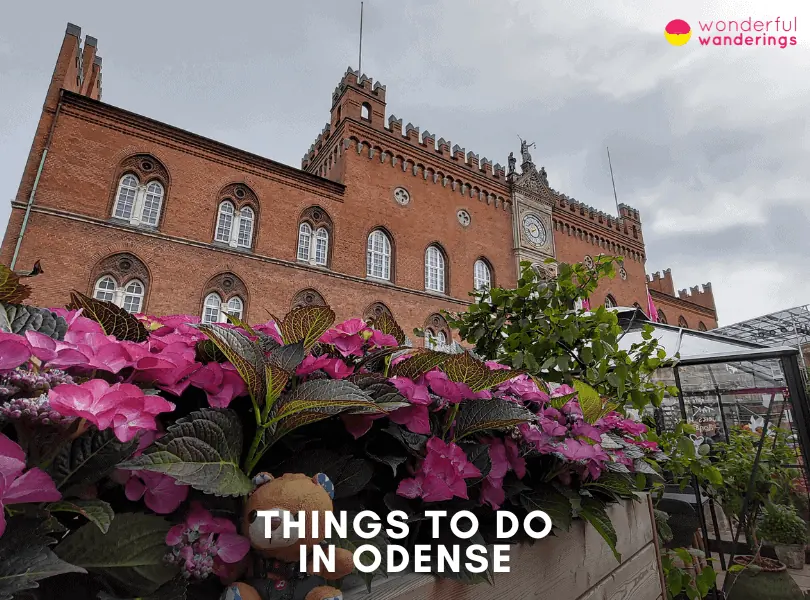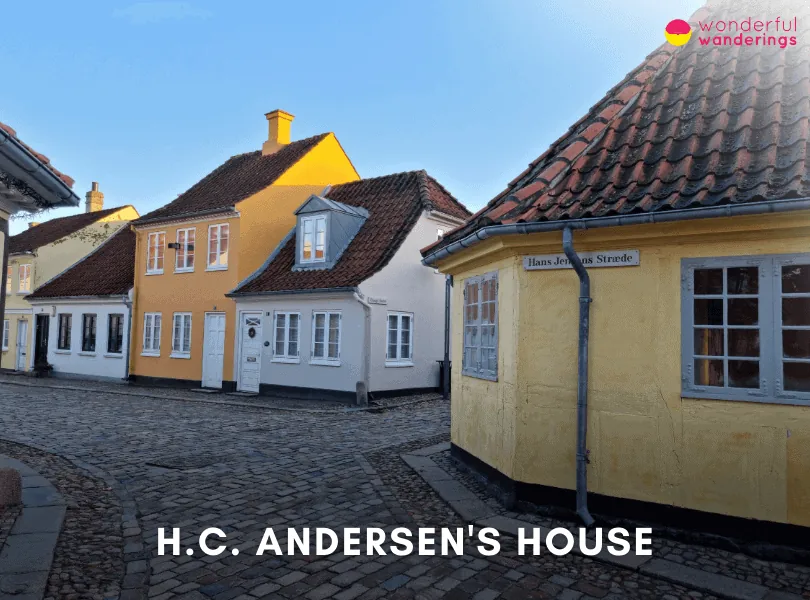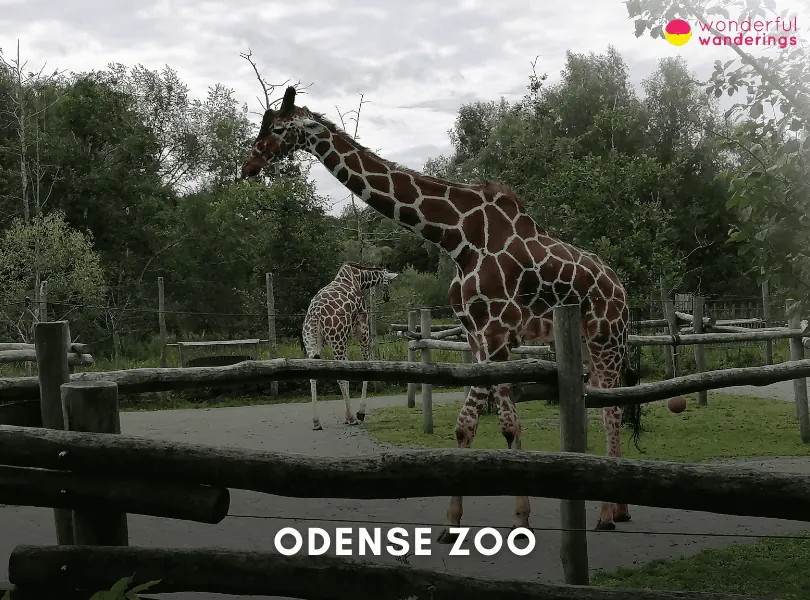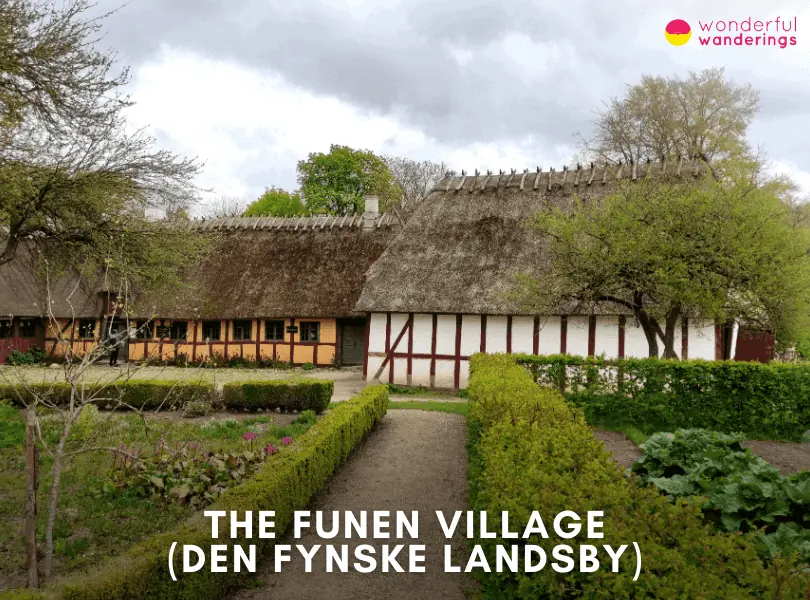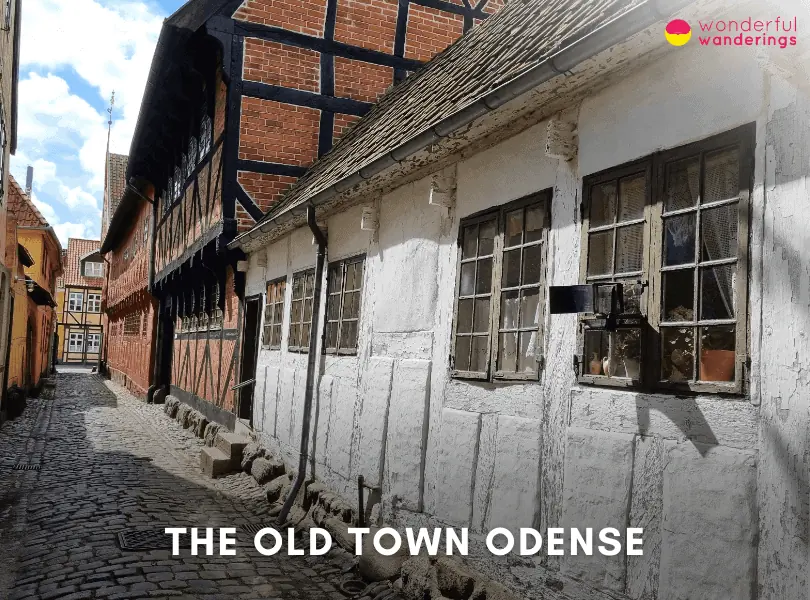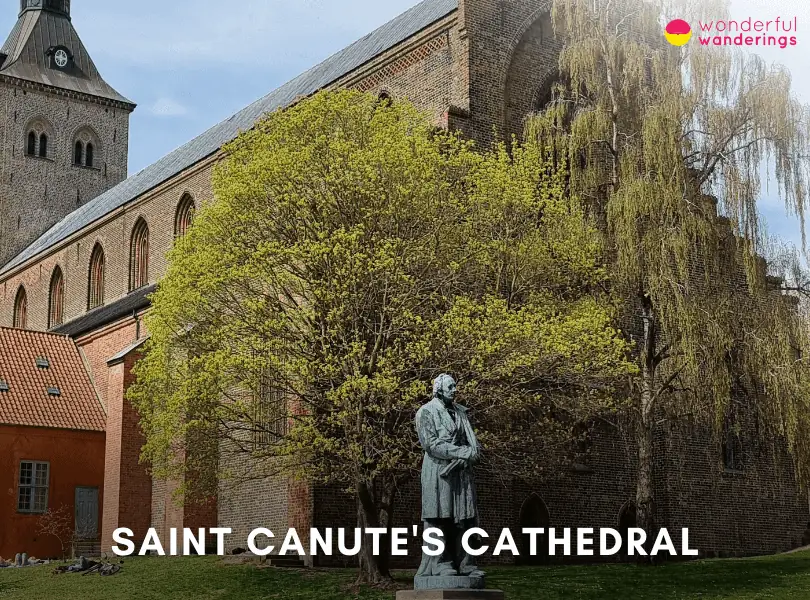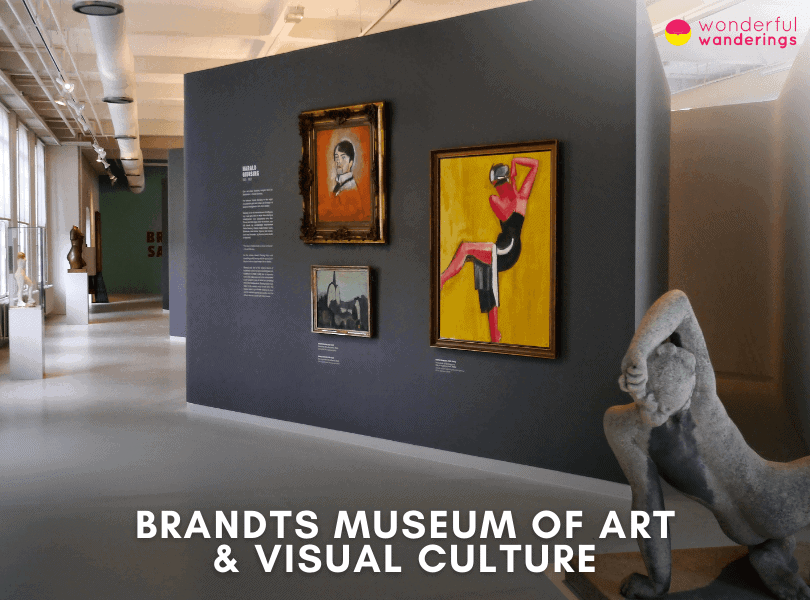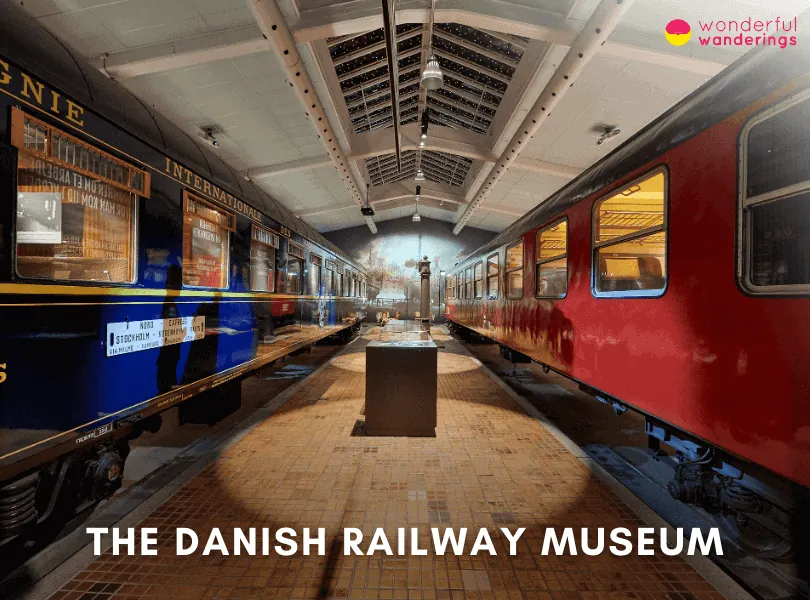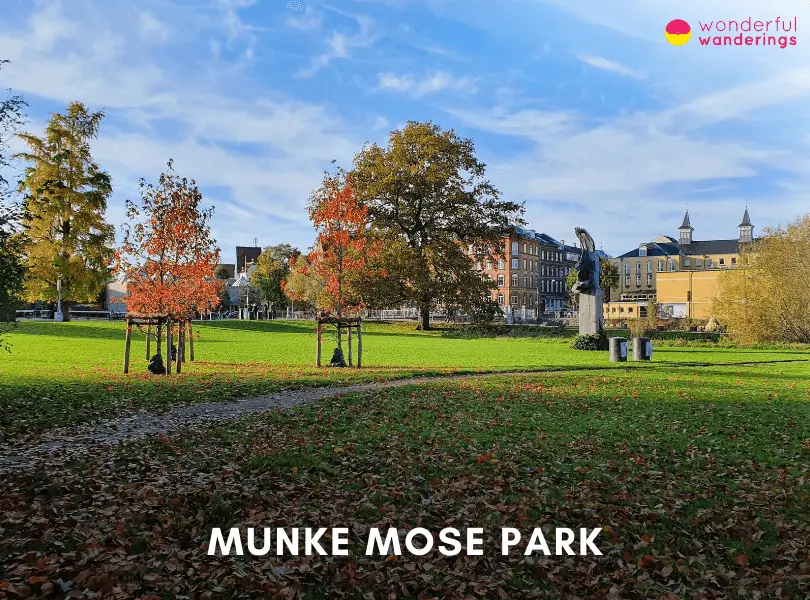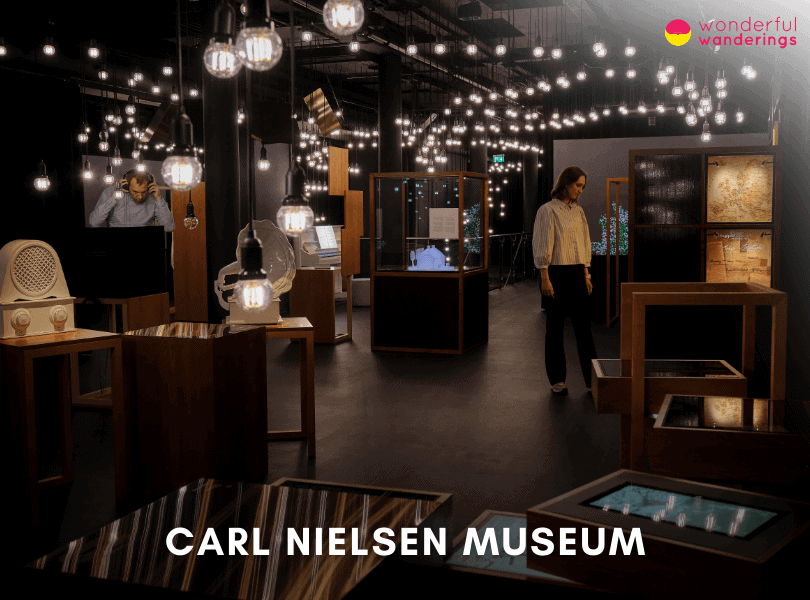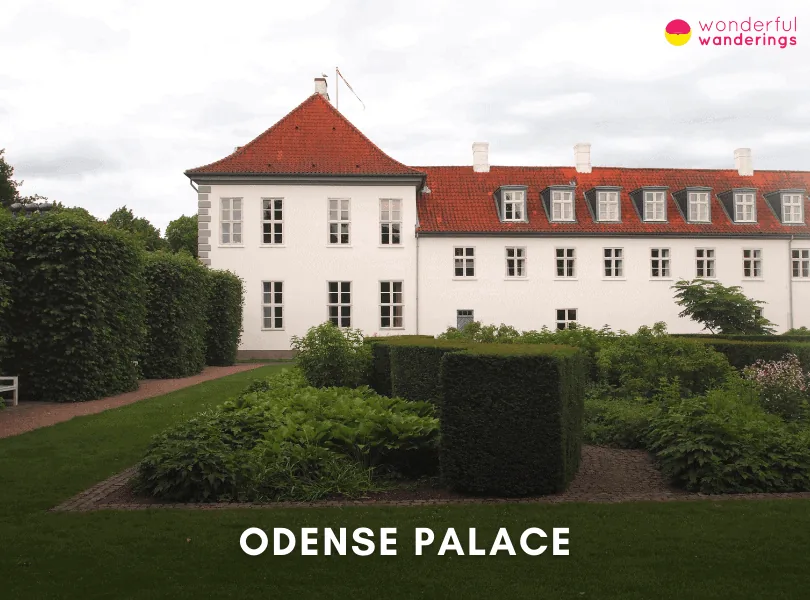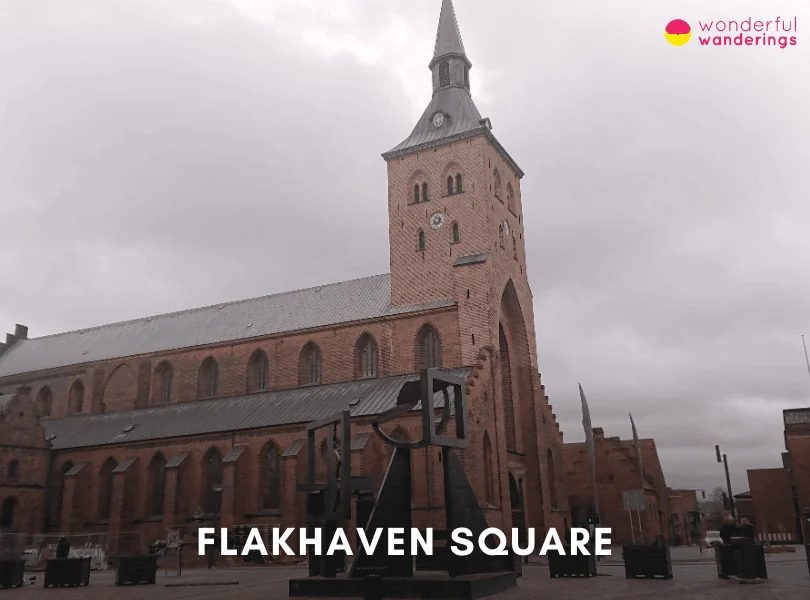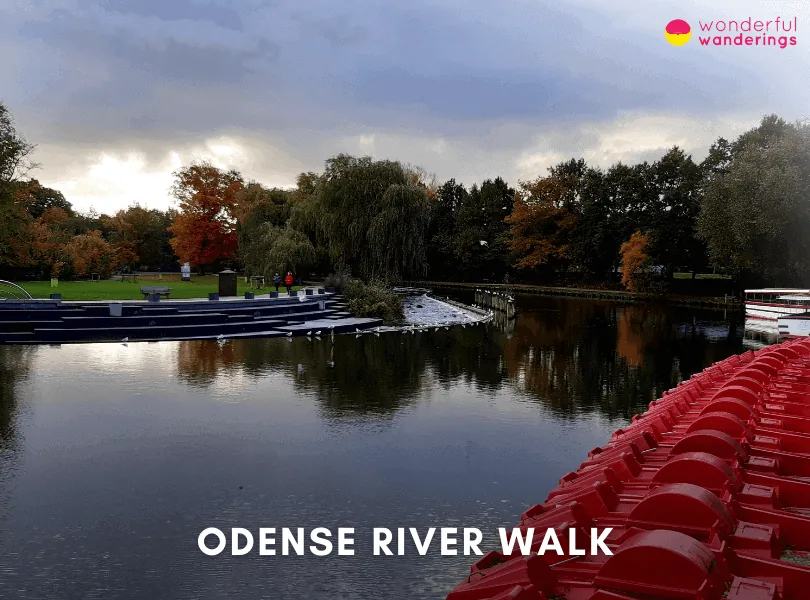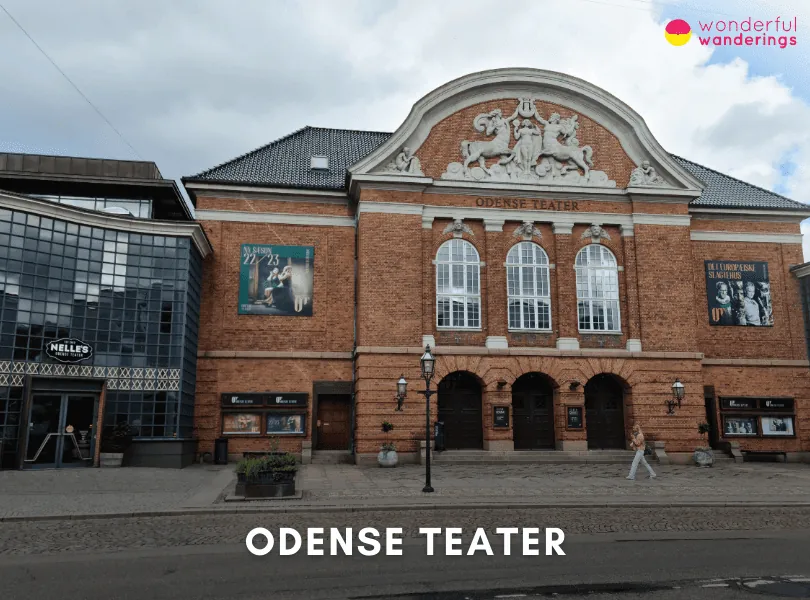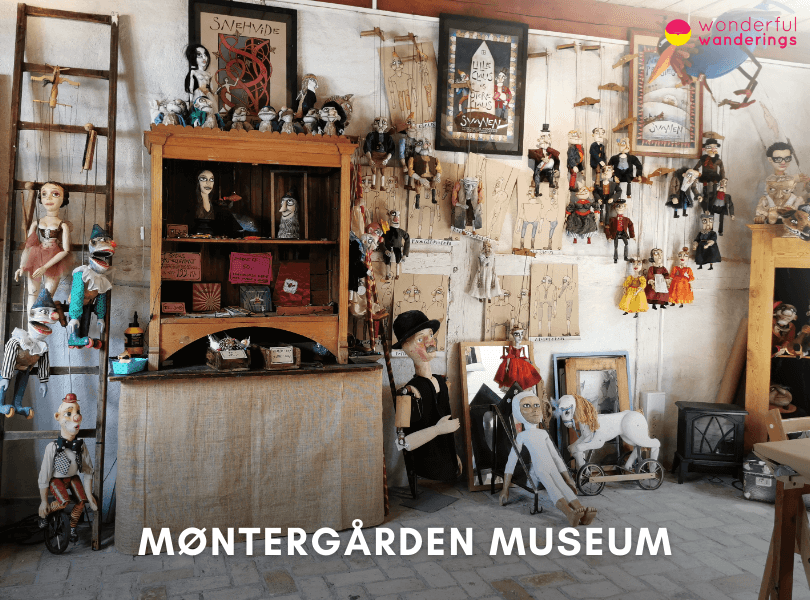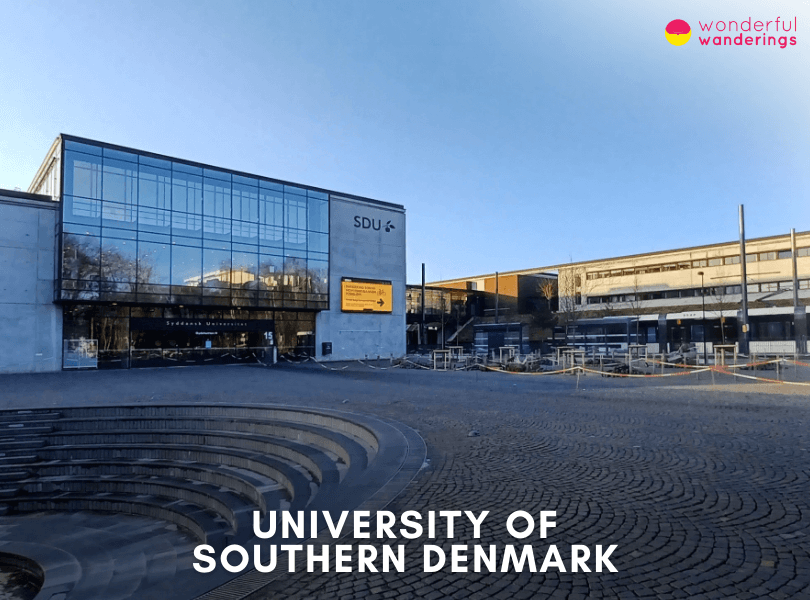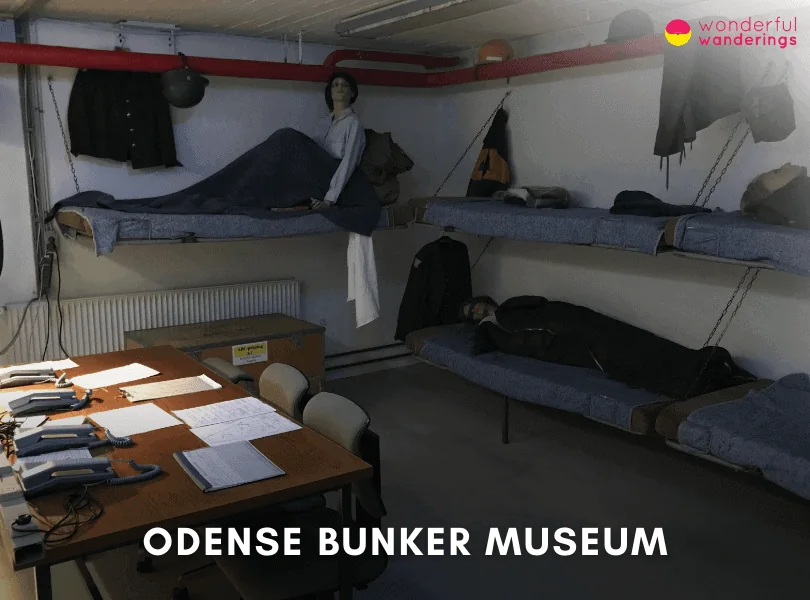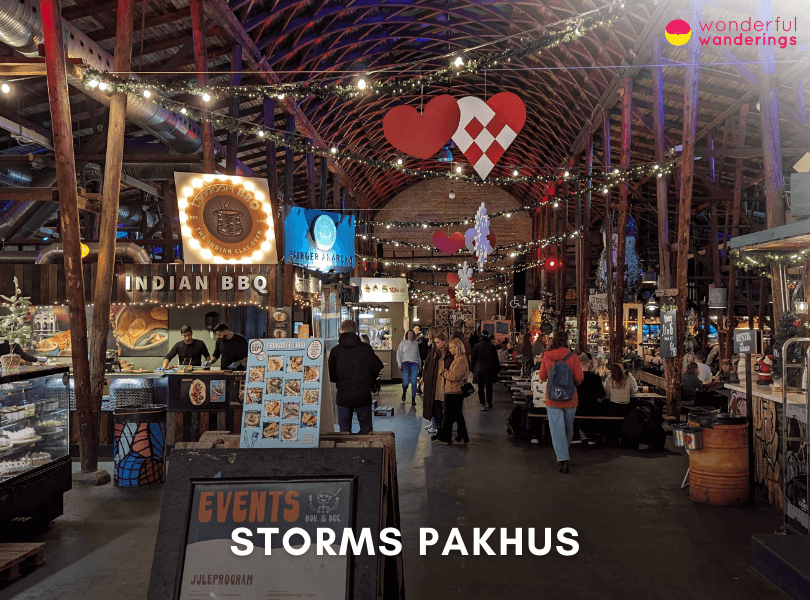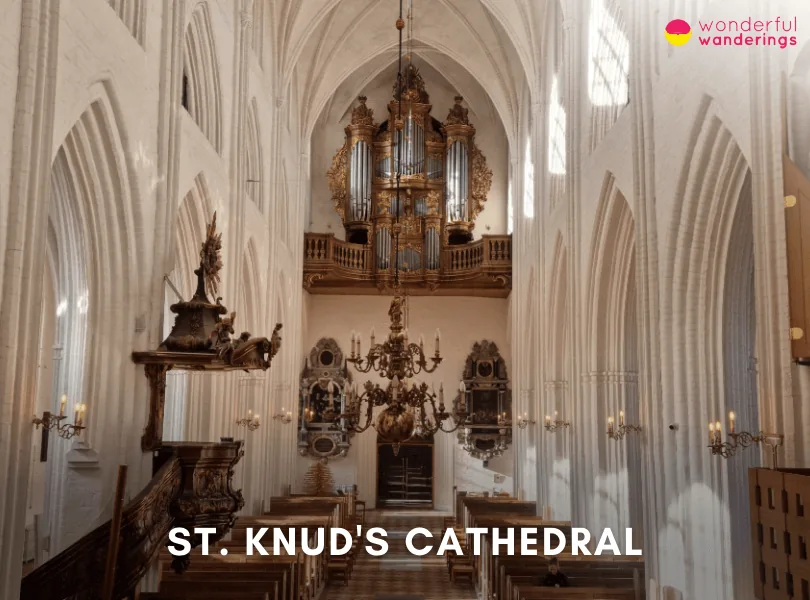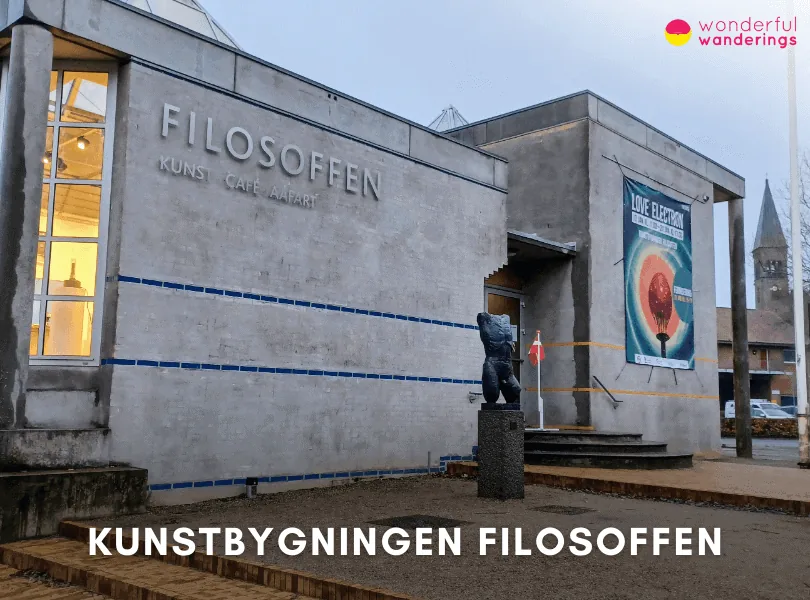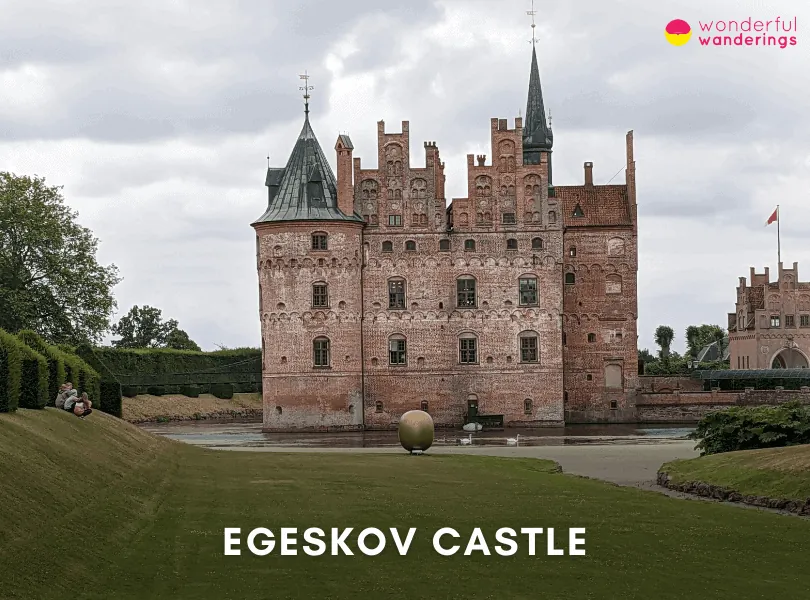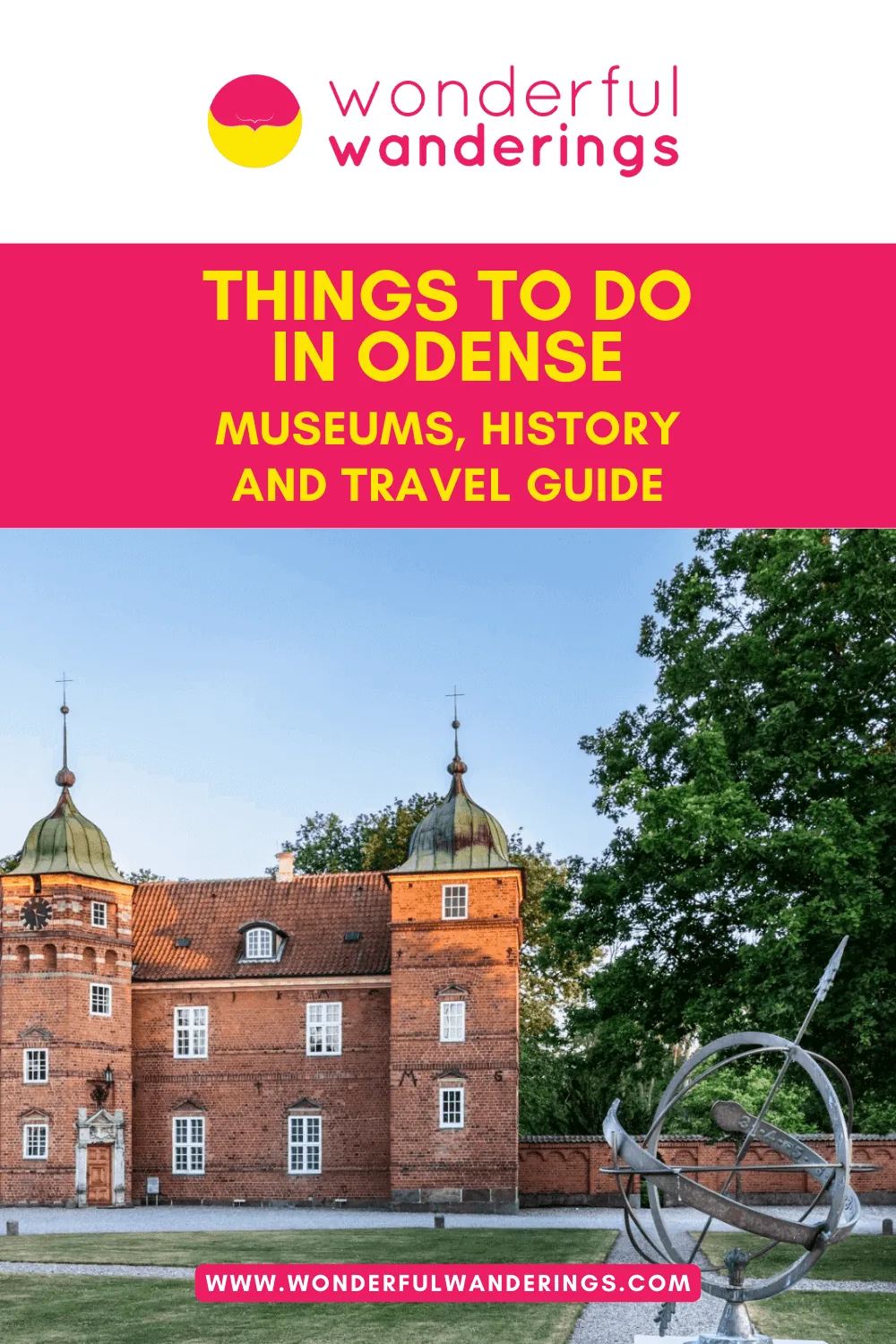Odense is a city steeped in cultural and historical significance and many attractions suitable for all ages make it a must-visit destination. Odense is known as the birthplace of Hans Christian Andersen and the city pays homage to this literary icon with the H.C. Andersen’s House museum complex. This includes the newly designed H.C. Andersen Museum by Kengo Kuma, Andersen’s birthplace and childhood home, offering a magical journey through his life and stories. Another family favorite is the Odense Zoo, a sprawling 42-acre zoological garden that houses over 2,000 animals and features engaging activities like giraffe and sea lion feedings. For a glimpse into historical Danish life, The Funen Village is an open-air museum that recreates a 19th-century village, while The Old Town Odense offers a walk through authentic medieval streets and structures. Saint Canute’s Cathedral, a stunning example of Gothic architecture, is a testament to Denmark’s medieval past. Art enthusiasts can visit the Brandts Museum of Art & Visual Culture, boasting an extensive collection of Danish art and international photography. The Danish Railway Museum presents a fascinating exploration of the country’s rail history and Munke Mose Park provides a serene green space for relaxation. The Carl Nielsen Museum, dedicated to the famous composer and the historical Odense Palace are notable attractions.
Odense’s museums are a highlight, offering diverse experiences. The Hans Christian Andersen Museum delves into the author’s imaginative world. The Brandts Museum of Art & Visual Culture showcases a remarkable array of Danish and international art, making it a haven for art lovers. For families with children, Odense is a delight. The city caters to its young visitors with attractions like the Odense River Safari, a scenic boat tour and The Funen Village, offering an interactive historical experience. The Odense Zoo is a hit among kids for its up-close animal encounters and the Odense Puppet Theater provides captivating performances for the little ones.
Odense offers pleasant spots like the Velodrome KaffVelodromefé Søll and Den Lille Smalle, ideal for coffee breaks or casual meetings. Odense provides a range of accommodations, from boutique hotels to cozy B&Bs, catering to various preferences and budgets. The city’s compact nature makes exploring on foot, by bike or public transport easy. When it comes to dining, Odense’s culinary scene is a blend of traditional and contemporary. Local delicacies like Smørrebrød, Stegt flæsk med persillesovs, Frikadeller and Æggekage offer a taste of authentic Danish cuisine. For shopping enthusiasts, areas like Rosengårdcentret and the pedestrian streets in the old town offer a mix of international brands and unique boutiques. Odense hosts several festivals and events throughout the year, including the Odense International Film Festival, Tinderbox Music Festival, Hans Christian Andersen Festivals and the Odense Flower Festival, each adding to the city’s cultural tapestry.
Listed below are the best things to do in Odense.
- H.C. Andersen’s House. H.C. Andersen’s House is a museum complex dedicated to the famous Danish author Hans Christian Andersen. It consists of the new H.C. Andersen Museum designed by Kengo Kuma, which opened in 2021, the H.C. Andersen Birthplace from 1805 and the H.C. Andersen Childhood Home, where he lived from ages 2-14. The innovative new museum features indoor and outdoor spaces that bring Andersen’s magical stories to life through architecture, art, design, light and sound. This activity is best for fans of literature and fairy tales and families with children.
- Odense Zoo. Odense Zoo is a 42-acre zoological garden in Odense, Denmark’s third largest city. First opened in 1930, it is home to over 2,000 animals across 140 species in naturalistic habitats representing different continents. Highlights include the 5,300 square meter walk-through aviary, giraffe and sea lion feedings, endangered species breeding programs and themed areas like the African Savannah and Asian Rainforest. Odense Zoo provides an entertaining and informative day out for visitors of all ages, especially families with children.
- The Funen Village (Den Fynske Landsby). The Funen Village is an open-air museum in Odense, Denmark that authentically recreates a 19th-century Danish village. Spanning over 80,000 square meters, it features over 40 original period buildings, including houses, farms, a church, a school, a mill and an inn. The Funen Village provides a vivid glimpse into traditional Danish culture and architecture. It brings the sights, sounds and activities of a 19th-century village community to life. This activity is best for history buffs, architecture enthusiasts and families with children.
- The Old Town Odense. The Old Town Odense is a historic district in central Odense, nestled between Odense Cathedral to the north and the Odense River to the south. Unlike some open-air museums, most buildings here are original medieval structures, some 400+ years old. Visitors can freely stroll the charming cobblestone lanes and hidden courtyards to admire the well-preserved half-timbered houses and flowers. Museums like Hans Christian Andersen’s birthplace provide insight into his humble upbringing and development as a writer in this neighborhood. This activity is best for architecture enthusiasts, history buffs and families with children.
- Saint Canute’s Cathedral. Saint Canute’s Cathedral, known as Odense Cathedral, is located at Klosterbakken 2, 5000 Odense C, Denmark. It is a Gothic brick cathedral named after King Canute IV of Denmark, who was assassinated at the site in 1086. The cathedral enjoys an easily accessible location in central Odense, just a 10-minute walk from the train station. Visitors can explore the historic Gothic architecture and royal tombs utterly free of charge. Saint Canute’s Cathedral offers a glimpse into medieval Denmark right in the heart of Odense. This activity is best for architecture enthusiasts, history buffs and families with children.
- Brandts Museum of Art & Visual Culture. Brandts Museum of Art & Visual Culture is located in central Odense, Denmark, steps from the pedestrian shopping streets and close to landmarks like Odense Cathedral and H.C. Andersen’s childhood home. Brandts has an extensive international photography collection. Visitors can explore five floors of galleries, enjoy happy hour drinks on Thursday nights, attend concerts and lectures and visit the museum shop and café. This activity is best for art enthusiasts, photography buffs and families with children.
- The Danish Railway Museum. The Danish Railway Museum is Denmark’s national railway museum, located at Dannebrogsgade 24, 5000 Odense C, directly across from Odense Train Station. It showcases the history of rail transport in Denmark with around 50 locomotives and carriages on 20 tracks, including iconic trains like the royal funeral engine and the famous red “lightning train”. Visitors can explore passenger cars, signal boxes, platforms and board-specific machines. The museum runs heritage trains along its tracks as well. This activity is best for train enthusiasts, history buffs and families with children.
- Munke Mose Park. Munke Mose Park is a large 42-acre public park located along the Odense River in central Odense, Denmark. Originally a boggy meadow prone to flooding, it was developed into a public park in 1915 based on designs by landscape architect Edvard Glæsel. Visitors can take peaceful walks, have picnics, rent boats and enjoy concerts at the small island stage in summer. Munke Mose Park is free to enter and open to the public at all times as a municipal park operated by Odense Municipality. This activity is best for families with children, nature lovers and those who enjoy leisurely outdoor activities.
- Carl Nielsen Museum. The Carl Nielsen Museum is dedicated to the life and work of the famous Danish composer Carl Nielsen. Located at Claus Bergs Gade 11 in central Odense, the museum’s top floor features a sound collage of Nielsen’s compositions, from simple folk melodies to complex orchestrations. Visitors take a biographical journey through interactive displays exploring how Nielsen’s rural upbringing and early violin playing shaped his music. The museum is accessible in Odense’s pedestrian city center, 10-15 minutes from the train station. This activity is best for music enthusiasts, history buffs and families with children.
- Odense Palace. Odense Palace is located at Nørregade 36 5000 in Odense, Denmark. Initially built in the 15th century as a monastery, it became a royal residence after being acquired by the Danish Crown following the Reformation. Odense Palace enjoys an accessible central location about a 10-15 minute walk from Odense Train Station. Visitors can explore the palace’s well-preserved interiors, including the Great Hall, the Chapel and the Prince’s Suite. This activity is best for architecture enthusiasts, history buffs and families with children.
1. H.C. Andersen’s House
H.C. Andersen’s House is a museum complex in Odense, Denmark, dedicated to the famous author Hans Christian Andersen. It is located in Haven 1, 5000 Odense C, Denmark. The childhood home is located at 3-5 Munkemøllestræde, Odense C, very close to the cathedral in the heart of the old city center. The birthplace is at the corner of Hans Jensens Stræde 45 and Bangs Boder in central Odense. It consists of several buildings, including the new H.C. Andersen Museum, which opened in 2021, the H.C. Andersen Birthplace and the H.C. Andersen Childhood Home.
The famous Japanese architect Kengo Kuma designed the new H.C. Andersen Museum, which covers 5,600 square meters (60,278 square feet). It features indoor and outdoor spaces with exhibitions that bring Andersen’s stories and creative universe to life through architecture, art, design, light and sound. The museum has a children’s area and an underground section surrounded by a magical garden. It aims to speak like Andersen’s wonder and imagination rather than just present facts about his life.
Visitors can interact with multimedia exhibits that bring Andersen’s stories to life through light, sound and scenery. Speakers embedded throughout the presentations play audio in Danish, English and German to guide visitors. They can turn the handle of a giant metal nightingale sculpture or play with the shadow against an illuminated background. Other highlights include a Little Mermaid water installation that you can gaze through to see exhibits below, a hands-on area for kids to create paper cuttings like Andersen’s and displays of his original manuscripts and possessions.
The best way to get to H.C. Andersen’s House is by walking or biking, as it’s located right in the heart of Odense’s historic pedestrian city center. If coming from the Odense Train Station, it’s about a 15-minute walk. Head west on Banegårdspladsen, turn right onto Østre Stationsvej and keep straight as the road becomes Overgade. After passing the cathedral, turn left onto Jernbanegade, which leads directly to the museum.
H.C. Andersen’s House is an excellent place for everyone, especially families with children, literature enthusiasts and anyone interested in Danish culture and history. Admission to H.C. Andersen’s House costs DKK 161 (€23, $25, £20) for adults. Youth ages 18-25 pay DKK 119 (€17, $19, £15), while children and teens under 18 enter for free. Special rates are available for students, pensioners and groups. The ticket grants access to the entire museum experience, including the indoor/outdoor exhibits, underground areas, birthplace and childhood home.
2. Odense Zoo
Odense Zoo is a 42-acre zoological garden in Søndre Boulevard 306, 5000 Odense C, Denmark. The zoo is in the southern part of Odense, around 2 kilometers from the city center and Odense Train Station. First opened in 1930, it is now home to over 2,000 animals across 140 different species. The zoo is divided into themed areas representing different continents and habitats. Key sections include the African Savannah with giraffes, zebras and ostriches. The Asian Rainforest with tigers, red pandas and gibbons, the South American jungle with macaws, tapirs and capybaras and the Arctic Circle with penguins, seals and polar bears. Odense Zoo has the most extensive walk-through in northern Europe.
Visitors can observe flamingos, pelicans, storks and other exotic bird species up close as they fly freely overhead. Education and conservation are top priorities, with many threatened species like the manatee and ring-tailed lemur, breeding successfully at the zoo. Interactive experiences allow visitors to hand-feed giraffes or watch the zookeeper’s training demonstrations; Odense Zoo provides an entertaining and educational day out for all ages with its naturalistic habitats, rare species and engaging activities. Visitors can grab lunch at one of the zoo’s cafes before visiting the manatee tank or watching the animated meerkat colony.
Odense Zoo is conveniently located off a main road alongside the Odense River. The zoo is easily accessible via various transportation modes. By car, exit 52 from the E20 motorway onto Assensvej leads directly to the zoo’s free parking area. Odense Station is just a 15-minute walk or a quick taxi ride away if coming by train.
Odense Zoo attracts families and nature enthusiasts who want to observe various animals and their natural habitats. General admission to Odense Zoo costs DKK 149 (€20.12, $21, £17) for adults. Youths aged 18-25 pay a discounted rate of DKK 126 (€17, $18, £15). Children and teens under age 18 enter for free. Family packages are available, with two adults + 2 kids costing DKK 358 (€53, $57, £46). Additional discounts apply for students, pensioners and groups. Tickets grant access to the entire zoo for a whole day.
3. The Funen Village (Den Fynske Landsby)
The Funen Village or Den Fynske Landsby, is an open-air museum in Sejerskovvej 20, 5260 Odense S, Denmark. It is situated in the Fruens Bøge district of Odense, Denmark’s third-largest city on the island of Funen. It features over 40 buildings sourced from around the Funen region, reconstructed to create an authentic 19th-century Danish village environment.. The Funen Village transports visitors back in time to experience rural life as it was in the 1800s. The Funen Village is sometimes called Den Fynske Landsby, the Danish name for the open-air museum. Locals may call it Landsbyen, meaning “the village”. But its official name in English and most commonly used is The Funen Village.
Visitors can wander through the network of dirt pathways at their own pace, exploring the various houses, farms and institutional buildings. Special events like reenactments, concerts or activities bring added life to the village on certain days. The Funen Village has a restaurant serving traditional open-faced sandwiches and cake. The Funen Village enjoys a convenient location by simply taking Route 43 heading south from Odense and turning right onto Sejerskovvej, following signs for the museum. For public transport, visitors can take Bus 42 from the central Odense Train Station, which stops at the museum entrance. The trip takes just 15 minutes. Cyclists can follow Odense’s bike lane network heading south, with the village well-signed from the route.
The Funen Village is an excellent activity for families and anyone interested in history and culture. General admission to The Funen Village is DKK 59 (€8, $9, £7) for adults. Youths aged 18-25 can enter for a discounted rate of DKK 44 (€6, $6, £5). Children and teens under age 18 get free admission. Family tickets are available at reduced bundled pricing. The entry fee provides access to all areas of the open-air museum for a whole day.
4. The Old Town Odense
The Old Town Odense refers to the historic district in Overgade 48 in Odense C. It stretches across several blocks east of Kongensgade Street up to Vindegade. The community can be found nestled between Odense Cathedral to the north and the Odense River to the south. Key streets include Overgade, Nedergade, Bangs Boder, Hans Jensens Stræde and Munkemøllestræde. The City Museum Møntergården address is Overgade 48 in Odense C, while Hans Christian Andersen’s childhood home is located at 3-5 Munkemøllestræde, in Odense C very near the cathedral.
Unlike some open-air museums, most buildings within the district are original structures that have stood at their locations for up to 400+ years. This lends an extra level of authenticity to wandering the medieval streets. The interiors of sites like the Hans Christian Andersen museums and Møntergården are fully decorated with actual furnishings used in daily life during the eras they represent.
Visitors can take a peaceful stroll through the charming Old Town Odense, wandering the cobblestone lanes and narrow alleys to admire the colorful half-timbered houses adorned with flowers in summer. Visitors can duck through archways into hidden courtyards where locals relax at cafés and restaurants tucked amidst historic buildings. Visitors can stop to learn about the childhood of famous fairytale author Hans Christian Andersen at his well-preserved birthplace and childhood home. Hands-on exhibits provide insight into his humble upbringing and development as a writer.
The Old Town Odense is an ideal destination for history buffs, architecture enthusiasts and anyone interested in experiencing the rich cultural heritage of Denmark. The Old Town is centrally located in the heart of Odense, making it highly accessible via all modes of transportation when visiting the city. There is no admission fee to wander and explore the historic streets and lanes of the Old Town Odense district.
5. Saint Canute’s Cathedral
Saint Canute’s Cathedral, known as Odense Cathedral, is a medieval Catholic cathedral in Klosterbakken 2, 5000 Odense C, Denmark. Built in the 14th century, it is a fine example of Gothic brick architecture. The cathedral was constructed to honor King Canute IV of Denmark, known as Saint Canute, who was assassinated inside a wooden church on the same site in 1086. Saint Canute’s Cathedral has a long, vaulted nave lined with chapels. Notable features include the lavish baroque altarpiece carved by Claus Berg in the early 1600s and the ornate pulpit built in the late 1600s.
Visitors can explore the nave of Saint Canute’s Cathedral, admire the elaborate Baroque and Renaissance details and reflect on the peaceful chapels. Climb the tower for panoramic views from the top if it is open during the visit. Attend one of the organ concerts frequently held in the cathedral to experience the acoustics and artistry of the grand pipe organ. Visitors can attend services and daily prayers in the cathedral on certain days to witness its continuing religious function.
Saint Canute’s Cathedral is an easily accessible location right in central Odense. If arriving by train, it’s just a 10-minute walk west from Odense Train Station. Head towards the cathedral’s green spires visible across the city. Several paid parking garages are nearby for those driving, like the one under the Magasin department store just south of Vindegade. Local buses 10, 13, 14, 15 and 29 on the west side stop outside the cathedral along Klingenberg Street.
Saint Canute’s Cathedral is suitable for people of all ages and types, including families with children. There is no admission fee to visit Saint Canute’s Cathedral. Special events like concerts may have ticket prices, but general entry to the cathedral is free. Visitors to Odense can see this impressive Gothic church and the tomb of Denmark’s patron, Saint Canute, at no cost when touring the city.
6. Brandts Museum of Art & Visual Culture
Brandts Museum of Art & Visual Culture is an art museum located in central Odense, Denmark. The art museum sits right in Odense’s pedestrian city center, just steps from the main shopping streets. Nearby landmarks include Odense Cathedral, H.C. Andersen’s childhood home and the Hans Christian Andersen Museum. The museum’s collection includes over 15,000 works on 250 years of Danish art history. Highlights include Golden Age paintings, modernist works, contemporary installations and avant-garde pieces by regional Funen artists and Denmark’s most prominent masters like PS Krøyer, Vilhelm Hammershøi and Olafur Eliasson. Brandts has an international collection of 9,000+ works documenting artistic photography from World War II.
Brandts Museum of Art & Visual Culture visitors can explore five floors of galleries showcasing Danish art-changing international exhibitions. Appreciate Golden Age masterpieces, modernist experiments, contemporary installations, video projections and avant-garde works from Funen’s artists and the wider Danish scene. Pop into the museum shop, which stocks art books, prints and designer goods. Refuel at the atmospheric Brandts Art Café overlooking the central courtyard. Visitors can attend evening concerts, films or guest lectures in the strikingly converted industrial halls.
Brandts Museum enjoys a very central and accessible location right in the heart of Odense’s pedestrian city center. If arriving by train, Odense Station is an easy 10-15 minute walk away – head west following Vestergade shopping street directly towards Brandts’ brick smokestack visible in the distance. A paid parking garage is below the neighboring Magasin department store, with the museum entrance just around the corner.
Brandts Museum of Art & Visual Culture is suitable for all ages and is an excellent destination for art enthusiasts and anyone interested in Danish art history.
Adults have a general admission fee of DKK 89 (€12, $13, £11). Youths aged 18-25 and students can enter for DKK 67 (€9, $10, £9). Children and teens under 18 get free admission. Special rates are given to pensioners, groups and families.
7. The Danish Railway Museum
The Danish Railway Museum is Denmark’s national railway museum at Dannebrogsgade 24, 5000 Odense C, Denmark. The city of Odense. Established in 1975, it is housed in a former engine shed adjacent to Odense Train Station. Spanning over 10,000 square meters, the museum contains around 50 locomotives and railway carriages on 20 tracks, showcasing Denmark’s rail transport history. Key highlights include an E-class steam engine that pulled King Frederick IX’s funeral train, the iconic red “lightning train” Lyntog diesel express and a sectioned NOHAB diesel locomotive revealing its inner workings.
The museum features original railway buildings and items illustrating how railways shaped Danish infrastructure and society. Visitors can explore passenger and royal carriages, a vintage snow plow, model ferries, signal boxes and platforms. Interactive elements allow kids to sell tickets in a miniature railway station, operate model trains and play in the large outdoor area. Visitors can board royal saloon cars, vintage steam engines and even a funeral train. The museum runs special heritage trains along its tracks.
The Danish Railway Museum enjoys a very convenient location directly across the street from Odense Train Station. Visitors arriving by rail can walk straight from the station’s east exit and cross Dannebrogsgade Road to the museum. Intercity and regional trains connect Odense to cities across Denmark. There is parking available at the station for those driving. Local buses 10, 13, 14, 15 and 29 all stop along Dannebrogsgade right by the museum.
The Danish Railway Museum is an excellent attraction for railway enthusiasts, families and history buffs of all ages. General admission to the Danish Railway Museum is DKK 89 (€12, $13, £11) for adults. Younger visitors up to age 17 can enter for free. Discounted rates are given to students, pensioners and groups. Tickets allow access to all museum exhibitions and displays for a full day. Special events like heritage train rides may incur an additional cost.
8. Munke Mose Park
Munke Mose Park is a large public park in Odense, Denmark. It is situated along the Odense River, covers over 42 acres and provides a peaceful natural oasis within the city. The park’s history dates back to 1881 when Odense Municipality acquired the land, a boggy meadow prone to flooding in winter for ice skating. In 1912, funds were raised to develop the area into a public park, which opened in 1915. Designed by a known landscape architect, Edvard Glæsel, Munke Mose Park features winding walking paths, open green spaces and abundant trees and floral gardens.
Munke Mose Park offers visitors a wide range of activities to enjoy. One can take a peaceful stroll along the footpaths that weave through the park’s diverse landscapes. Visitors can stop to admire the floral gardens bursting with colorful blooms in spring and summer. Spot ducks and swans swimming in the river from benches along the water. They can take the path over the wooden bridge to the small island stage to enjoy a concert on a summer’s eve, rent a rowboat or kayak from the boathouse during summer and paddle along the river.
Munke Mose Park enjoys a highly convenient location right in the heart of Odense. It is easily accessible via various transportation modes. The best way to arrive at the destination is through walking, with the park located just 10-15 minutes on foot from Odense Train Station and the central shopping area around Kongensgade and Vestergade streets. Cyclists can follow the dedicated bike lanes leading to the park’s entrances across the city. Multiple local buses, including lines 10, 12, 14, 15, 29 and 33, stop along the park’s perimeter roads like Østre Stationsvej and Dannebrogsgade.
Munke Mose Park is free to enter and open to the public at all times as a municipal park operated by Odense Municipality. The park is an excellent destination for families with kids, nature lovers and anyone looking for a peaceful escape from the city’s hustle. Some minor activities carry fees, such as renting a rowboat or kayak from the boathouse during summer, but general park access is complimentary.
9. Carl Nielsen Museum
The Carl Nielsen Museum is dedicated to the life and work of the famous Danish composer Carl Nielsen. It is in Claus Bergs Gade 11, 5000 Odense C, Denmark. The top floor is the best music experience, featuring a sound collage of Nielsen’s compositions, from simple folk melodies to complex orchestras. Fragmented elements are woven together to capture the essence of Nielsen’s diverse yet characteristic musical language.
Carl Nielsen Museum is unique; it focuses on experiencing and understanding Nielsen’s music within the context of his life story. Unlike traditional composer museums, it moves beyond artifacts to let Nielsen’s works take center stage. Visitors can listen to and interact with his compositions while learning about the contexts that shaped them. Another unique element is the museum’s innovative sound collage on the top floor, which recontextualizes fragments of Nielsen’s music into a new contemporary work. The multimedia displays stand out for their creative approaches to exploring Nielsen’s biography through music.
Visitors are taken on a biographical journey through the composer’s life story, with his music as the driving force. On the ground floor, one can learn about Nielsen’s rural upbringing in Funen and early musical experiences playing folk tunes on violin. Interactive touchscreens let you examine photos, letters and manuscripts from his childhood.
The Carl Nielsen Museum enjoys a highly convenient location in the heart of Odense’s pedestrian city center. It is readily accessible via various transportation modes. If arriving by train, Odense Train Station is an easy 10-15 minute walk away. Exit the station and head west, following the street Vestergade directly towards the museum just past the concert hall.
The Carl Nielsen Museum is a must-visit for anyone interested in music and Danish culture and is suitable for people of all ages. General admission costs adults DKK 96 (€13, $14, £12). Youths aged 18-25 and students can enter for DKK 67 (€9, $10, £9). Children and teens under 18 get free admission. Tickets grant access to the museum’s entire exhibition for a whole day. Visitors can purchase combination tickets at reduced rates and visit nearby museums like the H.C. Andersen House. Special rates are given to pensioners, families and groups.
10. Odense Palace
Odense Palace is a historic palace in Nørregade 36 5000, Odense, Denmark. Initially built in the 15th century as a monastery for the Knights of St John, it became a royal residence and seat of power after the Reformation when the Danish Crown acquired it. Today’s main building is an elegant white Baroque structure designed by architect J.C. Krieger and completed in 1723. It has a symmetrical view with 13 bays and a central projection topped by a triangular pediment.
Odense Palace’s long and varied history makes it unique, having served as a monastery, noble residence, seat of authority and municipal building for over 500+ years. The palace’s conversion into an elegant royal place in the early 18th century makes it significant as a fine example of Baroque architecture in Denmark. The symmetrical facade and lavish interiors reflect influences from France and the Netherlands.
Odense Palace is currently closed to the public for tours or visits. It remains in active use by the municipal government of Odense. However, visitors can still view the elegant exterior of the palace when passing by or exploring the adjacent King’s Garden. One can stroll around the palace complex and appreciate the symmetrical Baroque facade with its 13 bays, triangular pediment and stone details. The palace chapel on the north side gives a glimpse into the building’s past. Visitors can pause in the King’s Garden just west of the palace to view the entire palace complex.
Odense Palace enjoys an easily accessible location right in the heart of central Odense. Visitors arriving by train can walk from Odense Station to the palace in 10-15 minutes. Head west from the station towards Odense Cathedral, then turn north up Jernbanegade Street, which leads directly to the palace grounds.
There is no admission fee to view Odense Palace, as the building is closed for interior tours or access. Visitors can freely view the exterior of the palace from the surrounding streets and King’s Garden Park without any cost. They can walk around the palace grounds to admire the architecture from the outside and admission tickets or payments are not required. However, an admission fee would likely apply for interior access if the palace were to reopen for public tours. For now, the exterior of Odense Palace can be seen at no cost when walking through central Odense.
11. Flakhaven Square
Flakhaven Square is the central square in Flakhaven 2, 5000 Odense C, Denmark. It is between Vestergade and Overgade streets, about a 5-minute walk from Odense Cathedral and the Hans Christian Andersen Museum. The name “Flakhaven” translates to “flat garden” in English, as the area was an enclosed grazing land in ancient times before becoming a square.
Flakhaven Square has historically been the site of events and gatherings in Odense since the 1200s. It has served as a central market square and hosted the largest markets in Denmark. The court is home to prominent landmarks like the Odense City Hall and St. Canute’s Cathedral, making it the city’s heart. Flakhaven Square hosts various cultural events year-round, including concerts, festivals and markets and is surrounded by restaurants and cafes. It features unique sculptures like the bronze Triton statue called Oceania and other art installations.
Visitors to Flakhaven Square can admire its historical buildings like the Odense City Hall and Cathedral, view the unique Oceania sculpture and other art installations around the square, browse the restaurants and cafes lining the square, attend various cultural events and concerts held in the court or relax in the open area. The yard offers a central spot to explore Odense on foot, surrounded by shopping streets and close to landmarks like the Hans Christian Andersen Museum.
Flakhaven Square suits all visitors, including families with kids, couples and solo travelers. Visitors can take the train or bus to Odense Station, then walk about 12 minutes via Vestergade into the square. There is no admission fee to enter Flakhaven Square, as it is a public open space. Visitors can freely access the court and attractions like the Oceania statue. However, some events hosted here, like concerts, may have paid tickets. The restaurants and attractions surrounding the square, like Odense City Hall, have their admission fees.
12. Odense River Walk
Odense River Walk refers to the scenic walking and cycling paths along the Odense River through the city center and its parks. Odense River Walk runs along the Odense River through central Odense, from Eventyrhaven Park near Odense Cathedral and City Hall to Skovsøen Lake in Fruens Bøge forest on the outskirts. The path starts in the city center, 5000 Odense C, Denmark and leads south through scenic parks like Munke Mose and Fruens Bøge.
Odense River Walk offers a unique way to experience Odense’s nature and sights on foot or by bike. The path provides easy access to attractions like the Odense Zoo, surrounded by forests, greenery and scenic river views. As Denmark’s National City of Cycling, the route exemplifies Odense’s bike-friendly infrastructure.
Visitors can walk, jog or bike along the scenic path at their own pace while taking in sights like the river, gardens, zoo enclosures and more. One can stop for playgrounds, exercise stations, picnics, cafes or attractions. Visitors can rent a paddle boat, take an Odense River cruise, join walking tours, geocache and relax streamside. Parts connect to other paths and parks to explore.
Odense River Walk is easily accessible on foot or bike from Odense city center hotels and train station. One can take buses 2A, 4A and 5A to Munke Mose stop right by the route. Odense River Walk is suitable for people of all ages who enjoy walking, jogging, cycling and exploring nature. There is no admission fee to access and use Odense River Walk, as it is a public path open to all. Some attractions along the route, like the zoo and boat tours, charge entry fees.
13. Odense Teater
Odense Teater is a theater located in Odense Teater, which is situated at Jernbanegade 21, 5000 Odense C, Denmark. It is in the heart of Odense city center, close to Odense Cathedral and the Hans Christian Andersen Museum. With a history dating back to 1796, it is the second-oldest theater in Denmark. Odense Teater has three stages – the main Store Scene stage that seats nearly 500 people, the more intimate Værkstedet stage and the small Foyer Scene stage.
Visitors to Odense Teater can attend theatrical productions and performances at the theater’s three stages almost year-round. The main attractions are plays, musicals, ballet and dance shows and presentations for children and families. Before or after performances, visitors can explore the interior architecture of the historic 1914 building. The theater offers guided tours on select days for those wanting to learn more about its history and architecture. Visitors can dine at the theater’s cafe, which has views overlooking King’s Garden.
The theater is about a 10-minute walk from Odense Train Station, allowing visitors to walk there upon arriving by train. Multiple city buses, including lines 41, 42 and 302, stop near the theater on Jernbanegade. Visitors coming from Copenhagen Airport can take the train directly to Odense Station. There is street parking near the theater, though it is limited. Many visitors rent bikes or walk from hotels in the city center. The central location of Odense Teater enables visitors to easily visit on foot or using public transport once in Odense.
Odense Teater caters to various audiences, including children and families, theater enthusiasts and those interested in ballet and dance shows. There is no admission fee to enter the Odense Teater building itself. Visitors can explore the public areas of the theater complex for free. However, tickets must be purchased to attend the various productions and performances at Odense Teater’s stages. Ticket prices vary depending on the show. Popular shows and musicals typically range from DKK 1,593 (€215, $230, £190) to DKK 4,004 (€539, $575, £475) per ticket. More affordable options like children’s shows can cost DKK 96 (€13, $14, £12) to DKK 1,593 (€215, $230, £190).
14. Møntergården Museum
Møntergården is the cultural history museum located in Overgade 48, 5000 Odense C, Denmark. Situated amidst charming courtyards and beautiful half-timbered houses dating from the Renaissance period, it comprises the main museum building housing the “Funen – Centre of the Universe” exhibition along with historic homes like the 1546 Falk Gøyes Gård and a 17th-century almshouse. Key attractions include the “Life in the City” exhibit tracing Odense’s journey from the Middle Ages to the Renaissance and the hands-on children’s museum, Histotoriet. It showcases Odense and Funen’s cultural heritage through artifacts and exhibits spanning the Viking age to today.
Visitors to Møntergården Museum can explore its two main exhibitions and journey through Odense’s history and greater Funen. In “Funen – Centre of the Universe”, they can view hundreds of artifacts and interactives to learn about Funen’s Viking roots, the Middle Ages, the Renaissance period and more. The “Life in the City” exhibit provides insights into medieval and Renaissance Odense. Visitors can tour historic homes like the 1546 Falk Gøyes Gård nobleman’s residence and 17th-century almshouse interiors.
Families enjoy the hands-on Histotoriet children’s museum where kids can play, dress up and explore a recreated 1890s setting. Guided tours provide more insights while strolling through Møntergården’s scenic courtyards. The museum hosts special cultural events and activities throughout the year. Whether simply admiring the historic architecture, visitors to Møntergården gain a new perspective on Odense’s evolution through the centuries.
Møntergården enjoys a central location in downtown Odense that makes it easily accessible for visitors. Those arriving by train can walk from Odense Train Station to the museum in around 12 minutes via Vestergade. General admission to Møntergården
The museum costs DKK 96 (€13, $14, £12) for adults, free for children ages 0-17. It is an ideal destination for families with kids and anyone interested in exploring Odense’s rich cultural heritage. Discounted rates are available for groups of 20+ people. Special exhibitions or events may have additional ticket costs.
15. University of Southern Denmark
University of Southern Denmark (SDU) is a public university located in Campusvej 55 5230 Odense M, Denmark. It was established in 1998 through the merger of Odense University, the Southern Denmark School of Business and Engineering and the South Jutland University Centre. SDU has around 27,000 students and over 3,800 employees across five campuses in Odense, Slagelse, Kolding, Esbjerg and Sønderborg.
Visitors can tour the campus to view its unique architecture, known for its use of weathering steel and concrete. The campus center contains the main library, an impressive building surrounded by trees and offering comfortable study spaces. There are several cafes, auditoriums and open green spaces where students gather. Visitors can browse the campus bookstore or stop by one of the on-site cafeterias for a meal. The university has an active calendar of public events, including guest lectures, conferences, concerts and art exhibits. Guided campus tours may be available by appointment through the university’s visitor services.
The University of Southern Denmark has multiple campuses, but the main campus is Odense. Odense is easily accessible by several modes of transportation. Visitors can fly by plane to Odense Airport, which connects to Copenhagen and other European cities. Regular direct trains from Copenhagen to Odense take under 2 hours. The Odense train station is centrally located, about 2.5 km ( 1. 55 miles) from the university campus.
General admission to the University of Southern Denmark campus is free and open to the public. It is an ideal destination for families with kids and anyone interested in exploring Odense’s rich cultural heritage. Some specific facilities, such as the sports complex, may charge a small entrance fee. Special events like concerts and festivals may require purchased tickets. However, visitors can explore the main campus areas, library, exhibitions and outdoor spaces at no cost. Guided campus tours for prospective students and other visitor groups are complimentary.
16. Odense Bunker Museum
Odense Bunker Museum is a 450 square-meter nuclear bunker in Kragsbjergvej 99, 5230 Odense M. Odense, Denmark. It was built in 1953-54 during the Cold War era to house the emergency command center for Odense city officials and civil defense authorities. The bunker was designed to provide shelter and sustain up to 35 key personnel in the event of a nuclear attack or war with the Soviet Union. It contains electricity, ventilation, water supply and food stockpiles to keep it sealed off for up to a month. The bunker’s interior remains largely intact from when it was an active civil defense site until 2008.
Visitors to Odense Bunker Museum can take guided tours of the interior of the Cold War-era bunker. Tours provide an in-depth look at the various rooms and facilities within the 450-square-meter underground shelter. The communications room contains original phones, radios and cipher machines used to send coded messages. Visitors can ask questions of the knowledgeable guides about intriguing Cold War history and details of life in the bunker.
The Odense train station has regular direct service from Copenhagen and other cities and is 3 km ( 1.86 miles) from the museum. Visitors can take a taxi or local bus from the station or enjoy a pleasant walk to the bunker museum. If driving, Odense is located on the E20 motorway, providing easy road access. Paid street parking is available near the museum entrance.
Guided tours are included with admission and are offered on Saturdays and Sundays at 11 am and 2 pm. It is worth mentioning that the guided tours at Odense Bunker Museum are suitable for all ages. Only museum staff can provide access to enter the bunker. Photography and video filming are permitted inside. Admission can be paid in cash or by credit card at the museum entrance. Special group rates and tours may be available upon request.
17. Storms Pakhus
Storms Pakhus is a large street food market in Lerchesgade 4, 5000 Odense. It opened in 2017 and has quickly become one of the most popular attractions in the city. Storms Pakhus covers around 6000 m2 and contains about 24 food stalls, 6 bars and 12 creative workshops. It aims to promote local Funen food traditions and entrepreneurs in a relaxed, informal setting. The food stalls offer international street food using local ingredients, including tacos, burgers, pizza, ramen, Indian curries, sushi and more. The bars serve local Funen beers, artisan cocktails, wines and other drinks. Storms Pakhus hosts weekly events like live music, quiz nights, markets, dance parties and family activities.
Visitors to Storms Pakhus can explore the various international street food stalls, relax in the bars with local beer or cocktails and experience the creative workshops. Visitors can participate in crafts and upcycling workshops to make clothes or art from recycled materials and even visit an in-house hairdresser. There are often events like live music, dance parties, quiz nights, markets selling local goods, game nights and family-friendly activities.
Storms Pakhus is easily accessible by various modes of transportation. By car, several paid parking lots and garages are located close by on Vindegade, Seebladsgade and the surrounding streets. Public transport by bus is very convenient, with several buses stopping right outside Storms Pakhus on Seebladsgade, including lines 41, 42 and 43. Additional buses like lines 30, 31 and 32 stop at the Odense station just 1 km away.
It is a perfect destination for foodies, families and anyone looking for a relaxed and fun atmosphere to enjoy international street food and drinks. Entry into Storms Pakhus is free – no admission cost or tickets are required. The only costs are purchasing food and beverages from the various stalls and bars inside Storms Pakhus. The food stalls offer dishes ranging from DKK 52 (€7, $7, £6) to DKK 149 (€20, $20, £17). Drinks at the bars range from DKK 30 (€4, $4, £3) for a local beer to DKK 89 (€12, $13, £11) for a specialty cocktail.
18. St. Knud’s Cathedral
St. Knud’s Cathedral, known as Odense Cathedral, is a large Gothic-style cathedral located in Klosterbakken 2, 5000 Odense C. St. Knud’s Cathedral was built in the Gothic architectural style with imposing pointed arches, ribbed vaults and flying buttresses. The exterior is red brick with sandstone decorations around windows and doorways. Stained glass windows depicting various biblical scenes and saints filter in colorful light. The cathedral has undergone modifications and additions over the centuries, including a Gothic revival renovation in the 19th century.
St. Knud’s Cathedral is known as Odense Cathedral. Odense Cathedral is an alternative name used interchangeably with St. Knud’s Cathedral when referring to the same Gothic cathedral in Odense, Denmark, dedicated to St. Canute (Knud in Danish). St. Canute’s Cathedral or the Cathedral Church of St. Canute are sometimes used as names for this historic cathedral.
Visitors to St. Knud’s Cathedral can admire the impressive Gothic architecture inside and outside the cathedral. They can attend services and listen to organ concerts performed on the cathedral’s historic organ. Guided tours provide information about the cathedral’s history and artworks. There is a small gift shop selling souvenirs. Visitors are welcome to light candles, pray and experience the tranquil atmosphere within the soaring medieval cathedral. The cathedral hosts special events like concerts throughout the year as well.
St. Knud’s Cathedral is located in Odense city center, making it easy to access. Public transportation by bus is the most convenient way to reach the cathedral. Many local buses stop outside St. Knud’s Cathedral on Klosterbakken Street, including lines 101, 104, 107 and 110. Entrance to St. Knud’s Cathedral is free and open to the public, making it accessible for visitors on any budget. There is no admission fee to enter the cathedral and admire the architecture, artwork, stained glass windows and historic atmosphere. Guided tours are offered for a reasonable cost and provide more in-depth information about the cathedral. Special events like concerts often charge for tickets. However, visitors are welcome to enter and explore St. Knud’s Cathedral freely without any admission cost. Donations are appreciated to help maintain this historic landmark.
19. Kunstbygningen Filosoffen
Kunstbygningen Filosoffen, often referred to as Filosoffen, is located at Filosofgangen 30, 5000, Odense, Denmark. Filosoffen hosts events such as vernissages, art quizzes and art lectures, sometimes with the artists. It is a platform for uncensored exhibitions featuring new talents and hosts solo exhibitions, artist associations and national design exhibitions. The Filosoffen is known for its uncensored presentations, providing a platform for artists to express their creativity freely.
Visitors to Kunstbygningen Filosoffen can explore a wide range of art and design exhibitions. They can participate in art quizzes, attend art lectures and sometimes even meet the artists themselves. The Filosoffen hosts events, including vernissages, showcases new talents and established artists. Visitors can view some of the artworks on the Filosoffen’s Instagram page.
Kunstbygningen Filosoffen is located in the city of Odense, Denmark. Visitors can reach Odense by train, bus or car, depending on the starting point. Once in Odense, Kunstbygningen Filosoffen is easily accessible by public transportation, taxi or on foot.
Kunstbygningen Filosoffen is suitable for many audiences, including art enthusiasts, students, families and tourists. Its diverse exhibitions and events cater to different interests and age groups.
20. Egeskov Castle
Egeskov Castle is a magnificent Renaissance moated castle in Egeskov Gade 5, 5772 Kværndrup, Denmark. The nearest major city is Odense, about a 30-minute drive northeast of the court. Egeskov Castle is situated in a rural area of Funen surrounded by lush countryside and farmland. It is considered one of Europe’s best-preserved and most complete Renaissance castles. The castle was constructed in 1554 by Frands Brockenhuus and was built on oak piles in the middle of a lake, accessible only by a bridge.
Visitors to Egeskov Castle can explore both the interior of the castle itself as well as the surrounding grounds. Highlights of the court include the Great Hall with its frescoed ceiling, the knights’ hall with armor displays, the Renaissance chapel and the ornate bedroom suites filled with antique furnishings. The castle houses Titania’s Palace, an intricate doll house and collections of antique carriages, cars, motorcycles and aircraft. Visitors can walk through the tranquil castle gardens, considered some of Europe’s finest Renaissance gardens, admiring the fountains, sculptures and flower gardens. The oak labyrinth, treetop walking trail and petting farm provide family-friendly activities. Guided tours, concerts, festivals and Christmas markets occur on the castle grounds. There is a cafe and gift shop on site.
Egeskov Castle is located near Kværndrup on the Danish island of Funen. Visitors from Copenhagen can take a 1.5-hour train to Odense, then a 30-minute bus or taxi ride to Kværndrup, followed by a 5-minute drive or shuttle bus to the castle. Visitors from mainland Europe can take a ferry to Funen, then drive or public transport to the castle area. Local buses 108, 132 and 931 stop at Egeskov Castle from nearby towns.
Egeskov Castle offers a standard admission ticket with access to the castle, grounds, museums and activities. It is suitable for all types of visitors, including families with children who can enjoy the petting farm and treetop walking trail. Additional fees apply for guided tours, concerts, festivals and special events. General admission allows visitors to freely explore the castle exterior, gardens, museums and interior parts at their own pace without mandatory guided tours.
What are the best museums to visit in Odense?
Listed below are the best museums to visit in Odense.
- Hans Christian Andersen Museum. The Hans Christian Andersen Museum is located in the house where the famous author grew up in Odense, Denmark. Interactive displays and exhibits provide insight into Andersen’s life and literary works. The Hans Christian Andersen Museum, located in the house where the famous author grew up in Odense, Denmark, is best for visitors interested in learning about Andersen’s life and literary works through interactive displays and exhibits, including children who can engage with Andersen’s world.
- Brandts Museum of Art & Visual Culture. Brandts Museum showcases contemporary Danish art, design and photography in a former textile factory in Odense. Key features of the museum include changing displays of classical and modern art in 8-10 annual special exhibitions and a permanent collection with over 15,000 works of art, photos, films and drawings. Brandts Museum of Art & Visual Culture in Odense is an ideal destination for art enthusiasts interested in contemporary Danish art, design and photography and families with children who can explore hands-on exhibits focused on toys through history. The museum is known for its impressive collection from the 18th century to today.
- Funen’s Art Museum. Funen’s Art Museum is one of Denmark’s oldest museums, housed in a stately Classical building in Odense. It holds many works, including paintings, sculptures and Constructivist works by influential Danish artists like Jens Juel, H.A. Brendekilde, P.S. Krøyer and others. Funen’s Art Museum in Odense is perfect for art enthusiasts interested in Danish art from 1750-today, with a wide range of works, including paintings, sculptures and Constructivist works by influential Danish artists like Jens Juel, H.A. Brendekilde, P.S. Krøyer and others.
- The HC Andersen Children’s Museum. The HC Andersen Children’s Museum brings some of Andersen’s most famous fairy tales to life through creative sets and games. It is excellent for kids, with interactive exhibits and activities inspired by stories like The Little Mermaid, The Ugly Duckling and more. The HC Andersen Children’s Museum in Odense provides an experience for children to step into Andersen’s magical fairy tale worlds, with creative sets and games inspired by tales like The Little Mermaid, The Ugly Duckling and more.
- Møntergården. Møntergården is the cultural history museum located in central Odense. It is housed in a complex of historic Renaissance-style half-timbered buildings dating back to the 1600s. The museum provides insight into the history of Odense and the island of Funen through various exhibits and displays. Permanent exhibition “Funen – Centre of the Universe” showcasing Funen’s history from ancient times to the present day with hundreds of artifacts and interactive elements
What are the best things to do in Odense with kids?
Listed below are the best things to do in Odense with kids.
- Odense River Safari. The Odense River Safari is a boat tour that sails along the Odense River through the city of Odense. It is a fun activity for children to see the city from the river and spot wildlife like herons, swans and other animals living along the waterway. An experienced guide points out sights and provides commentary during the 1-hour river cruise.
- The Funen Village. The Funen Village is an expansive open-air museum outside Odense that recreates life in a traditional 19th-century Danish village. There are over 30 historic buildings to explore, including houses, farms, gardens, a windmill and more. Costumed guides demonstrate traditional crafts and activities using period tools and equipment. Domestic animals are grazing in the pastures and fields. The village is a look at rural Danish life during the era of the famous fairytale author Hans Christian Andersen.
- Odense Zoo. Odense Zoo is home to over 500 animals representing 100 species. Highlights include getting up-close views of tigers, red pandas, lemurs, kangaroos and monkeys in naturalistic habitats. Interactive elements like rope bridges suspended high in the trees provide fun activities for kids. The zoo has an Oceanium featuring manatees, penguins and other marine species and special events like feeding times, keeper talks and more.
- Odense Puppet Theater. The Odense Puppet Theatre carries on Denmark’s long tradition of puppetry arts. Artistic performances use hand-carved marionettes to present classic fairy tales and new Danish stories. The theater creates imaginative worlds incorporating music, sets and lighting designs explicitly crafted for the puppet stages.
- Blomstenholm Family Park. Blomstenholm is a seaside amusement park for younger children. The park has over 60 rides and attractions like bumper boats, vintage carousels, small roller coasters and a vast playground for kids. Special kid-friendly events and entertainment like meet-and-greets with costumed characters happen throughout the season.
What are the best activities for a business traveler in Odense?
Listed below are the best activities for a business traveler in Odense.
- Velodrom Kaffebar. Velodrom Kaffebar is aptly located in Finlandsgade 27B, 5000 Odense C, Denmark. This stylish yet casual cafe has an athletic theme with bike culture décor. It is known for its specialty coffee sourced from small batches and micro-roasters and freshly made sandwiches, salads and sweet treats. There’s outdoor seating in the front during nice weather. Velodrom Kaffebar is an excellent spot to get energized in between sightseeing.
- Café Sølle. Café Sølle is a cozy cafe located in Nørregade 31, 5000 Odense C, Denmark. Housed within exposed brick walls with dark wood fixtures, it has a classic Danish “hygge” atmosphere. The diverse menu includes breakfast options, open-faced sandwiches, salads and daily specials made from local ingredients. Café Sølle can get quite busy, especially on weekends.
- Den Lille Smalle. Den Lille Smalle is a tiny cafe in Vindegade 72B, 5000 Odense C, Denmark. Mismatched vintage furniture and ever-changing artwork cover the space. It is known for its fresh, quality coffee and impressive brunches. The menu changes seasonally, but typical items include avocado toast, omelets, porridge bowls and more made from organic produce. Get there early on weekends when seats fill up fast. Den Lille Smalle has no wifi, but it’s great for a relaxing break.
Where is Odense?
Odense is located on the Danish island of Funen in central Denmark. It is situated in the northeastern part of the island, around 30 km (19 miles) from the coast of the Great Belt strait, separating Funen from the more oversized Zealand island. Funen lies between the peninsula of Jutland to the west and Zealand to the east. Odense is centrally positioned on the Danish rail network with direct connections to Copenhagen and other major cities. It is Denmark’s third largest city by population, after Copenhagen and Aarhus.
Odense city GPS coordinates or geographic coordinates are 55.4038° N, 10.4024° E. This position gives Odense a humid continental climate influenced by the sea currents around Denmark. As such, winter temperatures hover slightly above freezing while summer highs peak around 22°C (72°F) on average. It is located centrally in Funen, Odense and is connected to vital Danish cities by significant transport routes. It is 167 km (104 miles) from Copenhagen by road or rail, taking just over an hour to reach the capital. The second city, Aarhus, lies 294 km (183 miles) northwest and is 2.5 hours away by highway and train. Odense is within easy reach of mainland Europe, only 150 km (93 miles) from the German border.
What is the history of Odense?
Odense has a long history dating back over 1,000 years. The name Odense is derived from Odins Vi, meaning “Odin’s Sanctuary”, as the area was a worship center for the Norse god Odin. The first recorded mention of Odense is in a letter from 988 AD granting trade privileges and recognizing it as a bishop’s seat. In the 11th century, King Canute IV was killed in Odense and later canonized, making the city an important pilgrimage site during the Middle Ages. Odense grew into a prosperous medieval market town and was chartered in 1335. After a period of decline, the city expanded rapidly in the 19th century with the construction of a canal linking Odense to the sea and later the arrival of the railway. Odense became a central industrial hub, home to companies like Albani Brewery. Since 1966, Odense has been a university city. The city is most famous as the birthplace of author Hans Christian Andersen in 1805.
What language is spoken in Odense?
The primary language spoken in Odense is Danish. Danish is the official language of Denmark and the primary language spoken by almost all residents of Odense and the surrounding Funen region. As a cosmopolitan city and university town, Odense has a significant population of immigrants and international students. Many residents speak English as a second language. Other minority languages spoken include Arabic, Turkish, Polish and German. Most signs, menus and information in Odense will be provided in Danish and English. As a popular tourist destination, English is widely spoken and understood in hotels, restaurants, shops and attractions.
What timezone is Odense on?
Odense is located in the Central European Time Zone, one hour ahead of Coordinated Universal Time (UTC+1). It uses Central European Summer Time (UTC+2) during the summer daylight saving period from the last Sunday in March until the last Sunday in October. Denmark observes daylight saving time, so the country switches time zones simultaneously. Odense has been in Central European Time since Denmark adopted it in 1893. The time in Odense is the same as in Copenhagen and most of continental Europe. Currently, when it is noon in Odense, it is 11.00 am UTC, 6.00 am Eastern Standard Time in the US and 3.00 am Pacific Standard Time in the US.
How many people live in Odense?
The total population of Odense as of 2023 is 147,929 people. There are 73,503 males and 74,426 females living in the city. The median age of residents in Odense is 42 years old. There are 23,689 children under 14 and 27,488 youths between the ages of 15 and 29. Odense has 27,159 adults aged 30-59 and 25,078 elderly residents aged 60 and above. There are about 8153 babies in Odense, with 3968 of them being girls and 4184 being boys. There are 7,752 young children between the ages of 5 and 9 living in the city. These are all based on the population breakdown.
What are the most interesting facts about Denmark and Odense?
Listed below are the most interesting facts about Denmark and Odense.
- Language. The language spoken in Odense and across Denmark is Danish. With around 6 million native speakers worldwide, Danish is the official language used in government, education, commerce and general communication by both locals and visitors in Denmark. As a North Germanic language, Danish shares similarities with its Scandinavian neighbors like Swedish and Norwegian when spoken.
- Timezone. As part of Denmark, Odense follows the Central European Time Zone (CET), which is 1 hour ahead of Coordinated Universal Time (UTC). It observes Central European Summer Time (CEST) by shifting clocks 1 hour forward to UTC+2 during the warm season.
- Currency. Denmark is a member state of the EU. Its official currency is the Euro, which replaced the former Danish Krone DKK as of January 1, 2023. The Euro banknotes and coins now circulating are a valid form of cash currency used in daily transactions by locals and visitors. Before adopting the Euro this year, Denmark’s financial autonomy meant the Danish Krone was pegged to the Euro at a fixed exchange rate for decades.
- Power Plugs. Odense and the whole of Denmark use the Type K power outlet and voltage standard of 230V at 50 Hz for household electricity supply. Visitors must use Type K plugs with two round prongs to operate their electrical gear or recharge devices in Denmark. Historically, there were different sockets, but EU standardization led Denmark to switch fully to Type K socket outlets and systems a few decades ago to match nearby countries.
How many days are needed to see Odense?
The days needed to see Odense are 2 to 3 days. In one day, visitors can visit the key highlights, including Hans Christian Andersen’s childhood home, the H.C. Andersen Museum and House, the Brandts Arts Center, Odense Cathedral, Møntergården historic houses and the shopping streets. Two days allow time to see more museums like the Hans Christian Andersen Fairytale House, take a riverboat tour or visit the zoo. Three days would provide a more relaxed visit to soak up the atmosphere, see more neighborhoods and visit nearby attractions like Egeskov Castle. Odense is quite compact so that the main sights can be seen on foot in the city center in 1-2 days.
Is Odense worth visiting?
Yes, Odense is worth a visit. As Denmark’s third largest city, Odense has plenty to offer visitors. Key highlights include exploring the medieval streets and buildings of the old town, learning about famous fairytale author Hans Christian Andersen, who was born here, seeing Odense Cathedral with its royal tombs and viewing the open-air museum of Funen Village. Odense has an array of museums, galleries, parks and gardens. The city has a thriving local food scene with cafes, restaurants and a street food market. It is situated on the island of Funen, Odense, which makes an easy and rewarding day trip or short break from Copenhagen. Even with limited time, visitors can taste quintessential Danish provincial life.
Is Odense expensive to visit?
No, Odense is not expensive compared to other major cities in Denmark or Scandinavia. As it is not as touristy as Copenhagen, prices for accommodations, food and attractions are more affordable. Hotels, apartments and vacation rentals can all be found at moderate rates. Budget food options include cafes, street food stalls and mid-range restaurants. Many top attractions like museums and churches have free or discounted admission. Odense offers good value compared to the high prices of visiting Copenhagen and Sweden. However, Denmark is still expensive by international standards, so travelers should expect higher costs than average.
Is Odense safe to visit?
Yes, Odense is a very safe place to visit. Denmark frequently ranks as one of the safest countries in the world and Odense is no exception. Violent crime rates are meager and tourists are unlikely to encounter any issues. Standard precautions, like being aware of pickpockets in crowded areas, should still be taken as in any city. The city center and tourist areas have a visible police presence and feel secure even at night. Use common sense, avoid isolated areas after dark and keep valuables secured. As a small city, Odense has limited risky areas. Visitors can feel confident walking around much of Odense day or night without safety concerns.
Is Odense easy to visit with kids?
Odense is a very child-friendly destination, making visiting with kids easy and enjoyable. Many attractions, like the Hans Christian Andersen Fairytale House interactive museum, cater specifically to children. Playgrounds are scattered around the city, such as the inventive facilities at Eventyrhaven. The city’s pedestrian streets provide space for kids to explore safely. Family-friendly dining and accommodation options are plentiful. Odense Zoo and attractions like Egeskov Castle, nearby appeal to children. Visiting sites related to famous children’s author Hans Christian Andersen is ideal for literary-loving kids. Odense’s manageable size and abundance of parks and green spaces create a pleasant environment.
What is Odense famous for?
One of the main things Odense is most famous for is being the birthplace of the favorite author, Hans Christian Andersen. Andersen was born in Odense in 1805 and spent 14 years in the city before leaving for Copenhagen. Many famous fairy tales that Andersen wrote, such as The Ugly Duckling, The Princess and the Pea and The Emperor’s New Clothes, were inspired by his childhood experiences in Odense. Beyond its link to Andersen, Odense has a long history stretching over 1,000 years. It was a significant Viking settlement with the remains of a 10th-century Viking ring fortress at Nonnebakken. Odense contains Denmark’s first saint, the martyred King Canute IV, whose shrine remains in St Canute’s Cathedral. The cathedral is one of the oldest and most impressive churches in Denmark. The flat terrain and a compact size, Odense is very bike-friendly. It has an extensive network of bike paths throughout the city and the surrounding countryside. Locals embrace cycling as an everyday mode of transportation. The city has over 300 bike paths, unique bike bridges and tunnels. Odense’s biking culture reflects the national passion for cycling in Denmark.
Who are the most important people born in Odense?
Listed below are the most important people born in Odense.
- Hans Christian Andersen. Hans Christian Andersen was a Danish author famous for his fairy tales and children’s stories like “The Little Mermaid”, “The Ugly Duckling”, and “The Snow Queen”. He was born in Odense, Denmark in 1805. He published his first book of fairy tales in 1835, gaining fame and eventually allowing him to travel Europe to socialize with nobility and other artists. Andersen wrote over 150 fairy tales and stories, which have been translated into over 125 languages. Andersen passed away in 1875, leaving a legacy as one of Denmark’s most influential writers.
- Viktor Axelsen. Viktor Axelsen is a Danish badminton player currently ranked number one globally. He was born in Odense, Denmark in 1994. Axelsen emerged as a promising badminton talent from a young age, winning several junior championships across Europe. His big breakthrough came when he won gold at the 2010 World Junior Championships. This marked him as a rising star in the sport. Axelsen steadily climbed the ranks on the professional circuit. He won his first Super Series title in 2017 and entered the world’s top 5 the same year. Axelsen career highlight came in 2020 when he won gold at the Tokyo Olympics, cementing his status as the best player in the world.
- Johan Kobborg. Johan Kobborg is a retired Danish ballet dancer, choreographer and artistic director, considered one of the leading male dancers of his generation. He was born in 1967 in Odense, Denmark and studied at the Royal Danish Ballet School. Kobborg went on to have a career of over 30 years as a premier danseur, performing principal roles at the Royal Danish Ballet, American Ballet Theatre and other top companies. Kobborg’s most acclaimed roles included Prince Siegfried in Swan Lake, Albrecht in Giselle and the title role in Romeo and Juliet.
What to eat in Odense?
Listed below are what you can eat in Odense.
- Smørrebrød. Smørrebrød is an open-faced sandwich made with rye bread, butter and various toppings like seafood, cold cuts, eggs and spreads. Popular toppings include pickled herring, roast beef, curried shrimp salad, hard-boiled eggs with mayo and chives, liver pâté and smoked salmon with dill. The combinations highlight contrasts in texture and flavor. Smørrebrød is an iconic part of Danish cuisine, with various creative varieties served in cafés and restaurants.
- Stegt flæsk med persillesovs. Stegt flæsk is Denmark’s beloved national dish of fried pork belly slices with crisp, crackly skin. It was served alongside a creamy parsley sauce made with milk, flour and lots of chopped parsley and boiled potatoes. Stegt flæsk provides an indulgent mix of flavors and textures from the salty, fatty pork contrasting with the mild, fresh sauce and starchy potatoes.
- Frikadeller. Frikadellers are juicy, pan-fried meatballs made from ground pork and veal. Onions and milk are added to the minced meat for moisture and lightness. They are shaped into small, flattened oval patties before frying to give the frikadeller its distinctive form. Frikadellers are crispy on the outside and tender inside, with a simple, savory flavor.
- Æggekage. Æggekage is a thick, cake-like omelet from Danish cuisine. Eggs are lightly beaten with milk or cream and baked in the oven, resulting in a puffy, airy texture. Æggekage is often cut into wedges and served warm, topped or filled with ingredients like crispy bacon, sautéed onions, tomatoes, cheese, fresh herbs or smoked fish. It makes for a hearty, comforting dish that can be served for breakfast, lunch or dinner.
- Tarteletter. Tarteletter are small Danish puff pastry shells filled with chicken or seafood salad. Chicken tarteletter may contain chicken breast mixed with mayonnaise, parsley, lemon and grapes. Seafood tarteletters are filled with shrimp, lobster or crab salad in a dill and mustard dressing. Tarteletter is a popular appetizer or lunch dish, served alongside other smørrebrød open-faced sandwiches for a light meal.
- Brunsviger. Brunsviger is a traditional Danish cake made with a moist, dense batter containing flour, sugar, butter and egg yolk. It is flavored with vanilla, cinnamon and cardamom and dotted with raisins. It is topped with a simple water icing and sometimes coconut flakes. Brunsviger is a classic coffee cake in Denmark, famous for breakfast or afternoon coffee breaks.
- Flæskesteg. Flæskesteg is roast pork, often prepared with pork loin or shoulder. The meat is rubbed with salt and spices and then roasted until tender and juicy. It is a beloved Sunday family dinner in Danish homes, especially for holidays like Christmas and Easter. Flæskesteg highlights pork, the most commonly eaten meat in Denmark and central to Danish food culture.
- Rødgrød med fløde. Rødgrød med fløde is a traditional Danish dessert consisting of sweetened red berry compote, typically made from currants or raspberries. Rødgrød is served cold, topped with cream or milk to balance the sweetness. It is customarily eaten in summer when fresh berries are often served at lunches or special occasions.
What are the best places to eat in Odense?
Listed below are the best places to eat in Odense.
- Kok & Vin. Kok & Vin is a cozy restaurant in Store Gråbrødrestræde, 19, 5000 Odense C, Denmark, a historic building in central Odense, specializing in seasonal Scandinavian cuisine. The menu features roasted duck breast, pan-fried cod and venison tenderloin, complemented by an extensive wine list. The interior combines rustic wood elements with modern Scandinavian design for a warm and inviting atmosphere. Kok & Vin reservations are recommended.
- Restaurant Bacchus. Restaurant Bacchus is an elegant French restaurant in Vestergade 96 B, 5000 Odense C, Denmark. The menu focuses on classic French cuisine using high-quality seasonal ingredients like foie gras, truffles and caviar. Signature dishes include steak au poivre, coq au vin and seafood bisque. The dining room features crystal chandeliers, white tablecloths and a fireplace for a refined atmosphere. Restaurant Bacchus offers an extensive wine list, including Old and New World selections.
- Restaurant Fynboen. Restaurant Fynboen is a cozy eatery in Nørregade 17, 5000 Odense C, Denmark. The menu celebrates traditional Danish cuisine using fresh local ingredients. Dishes like smørrebrød, frikadeller and grilled fish are prepared with creative twists. Fynboen offers an affordable prix fixe menu for lunch and dinner.
- GOMA. GOMA is a contemporary Japanese restaurant at Østre Stationsvej 15, 5000 Odense C, Denmark. The sushi and sashimi are fresh and artfully presented. Other highlights include tempura, robata grilled items and ramen noodles. GOMA offers a list of sake, beer and inventive cocktails like the Lychee Elderflower Martini.
- Restaurant Ribelli. Restaurant Ribelli is a cozy Italian trattoria in Overgade 23, 5000 Odense C, Denmark. The menu celebrates the flavors of southern Italy with dishes like wood-fired pizzas, Bolognese pasta and saltimbocca alla Romana. An affordable wine list offers a nice selection of Italian varieties. Restaurant Ribelli reservations are recommended, especially on weekends.
- Brasserie Bordeaux. Brasserie Bordeaux is a casual French restaurant at Kongensgade 72, 5000 Odense C, Denmark. The menu focuses on classic bistro fare like steak frites, moules frites and croque monsieur. Other highlights include the extensive beer list featuring local Danish brews and Trappist ales. Reservations are recommended, especially for outdoor patio seating.
What are the best areas to stay in Odense?
Listed below are the best areas to stay in Odense.
- Munke Mose. Munke Mose Park has surrounding streets like Munkevænget and Munkerisvej lined with elegant homes and a few small shops and eateries catering to locals. The real draw is the proximity to 148 hectares of protected wetlands, forests and fields offering walking/biking trails and wildlife watching just blocks away. Accommodation picks like Munke Mose Bed and Breakfast combine countryside calm with a quick 10-minute bus or bike tour to downtown.
- Hunderup/Frørup. Hunderup and Frørup retain their rural charm while now being districts of Odense. Sites like the Frørup Torv village square and Hunderup Seaside Church anchor these communities that seem apart from big city life yet are only a short drive to Odense. Cycling is prevalent and the ample farmlands and forests make for wonderful sightseeing outings. Given the distance from mainstream attractions, renting a car is wise if staying here.
- Vesterbro. Vesterbro is one of Odense’s trendiest and most up-and-coming neighborhoods, especially popular with students and young travelers seeking urban vibes. Many buildings maintain their historic facades while housing modern boutique hotels, microbreweries, concert spaces, etc. Accommodation options range from the design-forward boutique Hotel Ansgar to hostels like Danhostel Odense City. Vesterbro gives visitors a feel for Odense’s budding art and creative community through galleries and relaxed nightlife, which is less than a 20-minute walk from city sights.
- Tornbjerg. Tornbjerg is a quiet residential area perfect for families or those who prefer peace over city bustle. Tornbjerg Centret is a small shopping hub with grocery stores and valuable amenities for self-catering accommodations. The convenience of three nearby train stations provides easy public transport access to central Odense in under 20 minutes. Guesthouses and apartment rentals give homey, affordable options in this neighborhood, cherished for its community spirit and natural beauty.
- Seden and Stige. Seden and Stige appeal to visitors prioritizing space, serenity and quick highway access over central locations. Lower price points draw budget travelers to accommodations like Seden Strandcamping with tent and camper options. The highways and parking are readily available and having a rental car makes it easy to enjoy the peaceful charms of these suburbs while driving just 15 minutes into Odense’s downtown.
What are the best accommodations to stay in Odense?
Listed below are the best accommodations to stay in Odense.
- Hotel Skovpavillonen. Hotel Skovpavillonen is located at Claus Bergs Gade 7. This 4-star boutique hotel is on the edge of a forest near the Odense River. The modern Scandinavian-style rooms feature floor-to-ceiling windows, Nespresso machines and luxury bathrooms with heated floors. An on-site restaurant uses local ingredients, a fitness center and rental bikes to explore the area. Hotel Skovpavillonen is just a 12-minute walk from the Hans Christian Andersen museum.
- Hotel Odense. Hotel Odense is located at Odensevej 114. This budget hotel has rooms furnished with free Wi-Fi and flat-screen TVs. Guests can enjoy the buffet breakfast or rent bicycles to visit attractions like Odense Zoo. Meeting facilities, private parking and 24-hour front desk service are available. Hotel Odense is close to supermarkets, cafes and a playground.
- Comwell H.C. Andersen Odense. Comwell H.C. is located at Claus Bergs Gade 7. Named after the famous author, this 4-star hotel combines modern design with fairytale themes. Family rooms feature colorful decor and kids’ tents. Adults enjoy the on-site spa and fitness center. Comwell H.C., the lobby bar, serves Craft beers and light fare.
- Hotel Odeon. Hotel Odeon is located at Odeons Kvarter 1. This pet-friendly boutique hotel from the Brdr. Price Chain is set in a restored 19th-century building near Odense Concert Hall. Individually decorated rooms have unique art, exposed brickwork and rainfall showers. The gastropub offers Danish cuisine and special kids’ menus—an 8-minute walk to the city center.
- Great Northern. Great Northern is located at Kongensgade 77. This newly-built hotel has soundproofed rooms with Signature Sleep mattresses and 49-inch Smart TVs. Guests enjoy free coffee, tea and fruit. The Metro bar offers craft beers and cocktails with a complimentary appetizer for hotel guests. Great Northern is a walking distance to top city attractions.
How to get to from Odense to Copenhagen Airport?
Odense does not have a major international airport. The nearest major airport is Copenhagen Airport, about 105 km (65 miles) east of Odense. By car, it takes around 1 hour and 40 minutes to drive from Odense to Copenhagen Airport via the E20 motorway. The fastest way to get there is to take the train from Odense Central Station, which takes around 1 hour and 20 minutes and runs frequently throughout the day. Direct buses from Odense to Copenhagen Airport take between 1 and 30 minutes to 2 hours, depending on the route. Some other options for flying into Denmark and getting to Odense include flying into Billund Airport, about 90 minutes from Odense by train or bus or flying into Hamburg Airport in Germany, about 3 hours by train.
How to get from Odense to Aarhus?
The closest major city to Odense is Aarhus, located about 85 km (53 miles) to the northwest. The fastest and most convenient way to travel between the two cities is by train. Regular direct train services cover the distance in around 1 hour and 30 minutes. Trains run frequently throughout the day, with the first departure at 5.13 am and the last train leaving Odense. Driving is another option for getting from Odense to Aarhus. The journey takes slightly less by car – around 1 hour and 25 minutes in normal traffic conditions. The route mainly involves taking the E20 motorway northwest out of Odense before joining the E45 north towards Aarhus. The total driving distance is about 144 km (90 miles). Buses take longer than trains, at around 1 hour and 40 minutes.
Where to go shopping in Odense?
The Rosengårdcentret is one of the most popular shopping centers in Odense, located just a 10-minute walk from the train station. This mall has over 140 stores, including major international brands like H&M, Zara and Danish retailers. A supermarket, food court and playground make it a convenient one-stop shop. The pedestrianized shopping streets in the old town, such as Vintapperstræde and Kongensgade, are perfect for strolling between unique boutiques. Visitors can find Danish design shops, antique stores, specialty food shops like chocolatiers and clothing boutiques selling big Danish brands and local labels. This historic shopping district provides a charming backdrop while visitors can browse. The Brandts area is a shopping and cultural hub with an exciting mix of stores inside converted industrial buildings. Brandts has cool cafes, restaurants and a street food market so that visitors can take a break from shopping at one of the many eateries.
What festivals or events are taking place in Odense?
- Odense International Film Festival. The Odense International Film Festival (OFF) is an annual week-long event in late August showcasing short films from Denmark and worldwide. Established in 1975, OFF is Denmark’s oldest film festival in venues across Odense, including the Brandts Arts Complex. Awards are given for categories like Best International Short, Best Danish Short (qualifying for the Oscars) and Best Animated Short. There is an audience award. Selected films gain exposure to international audiences and industry professionals. In addition to screenings, OFF offers workshops, talks, concerts and parties. Attendance at screenings and events is free and open to the public. Around 25,000 people attend the festival annually.
- Tinderbox Music Festival. Tinderbox is a major multi-genre music festival held over three days in late June at the Tusindårsskoven Park in Odense. Established in 2015, Tinderbox has quickly become one of Denmark’s biggest and most popular music festivals. The event features a mix of prominent international acts and famous Danish artists performing rock, pop, hip-hop, electronic and indie music across five stages. Headliners in 2023 included Red Hot Chili Peppers, Maroon 5 and George Ezra. Over 45,000 music fans attend each day. In addition to performances, Tinderbox offers art installations, food stalls, a comedy stage and late-night parties.
- Hans Christian Andersen Festivals. The Hans Christian Andersen Festivals are weeklong cultural events held annually in late August to celebrate Odense’s famous fairytale author. Over 175,000 people take part annually. Festival highlights include outdoor plays bringing Andersen tales like “The Ugly Duckling” to life, concerts, exhibits, parades with costumed characters, street art and performances, readings, workshops, light shows illuminating historic buildings and more. Many events are free, with support from local businesses and sponsors. The goal is to engage people of all ages to fuel their imagination through art, stories and experiences that would make Hans Christian Andersen proud.
- Odense Flower Festival. The Odense Flower Festival is an annual event held each August that transforms the city center of Odense, Denmark, into a floral paradise. The festival features large floral installations and smaller exhibits created by professional florists, landscapers, volunteers and local companies. Each year has a unique theme that serves as inspiration. In addition to enjoying the beautiful flowers, attendees can participate in workshops, lectures, music performances and other family-friendly activities. The Odense Flower Festival began in 1999 and lasted from August 16-19, 2023. The displays and events are free and open to the public. Over 200,000 people attend annually, making it one of Odense’s most popular events.
- Odense Zoo Light Festival. The Odense Zoo Light Festival is an annual event from late November through mid-December that transforms the zoo into a magical winter wonderland. The light festival occurs every Friday through Sunday, starting November 24 through December 17 in 2023. The Odense Zoo Light Festival provides a unique way to experience the zoo when most animals sleep at night. The light displays are designed to be energy efficient. The Odense Zoo Light Festival started in 2015 and has become a popular holiday tradition in Odense.
PIN FOR LATER
Find below the best travel guides about Denmark.

